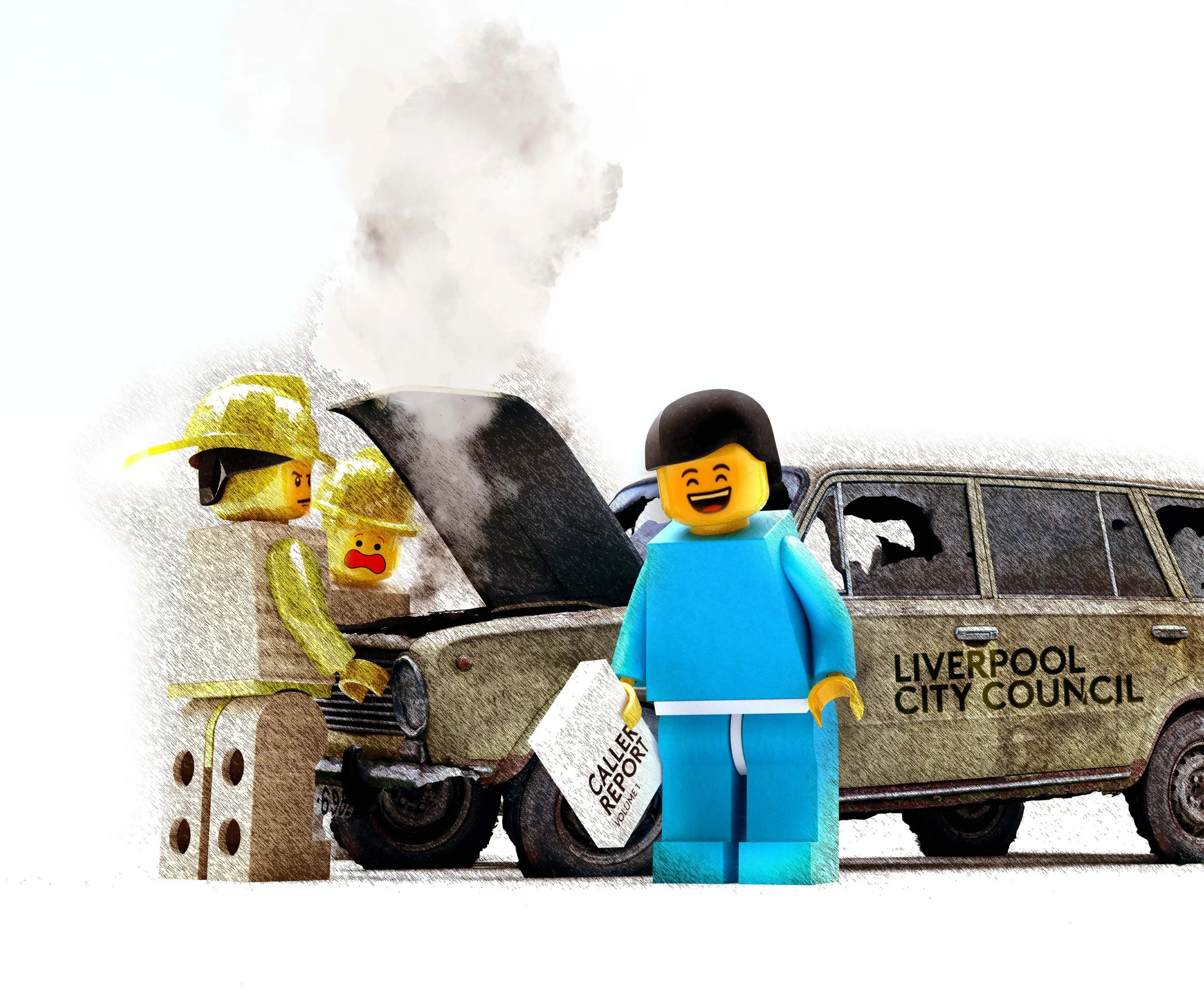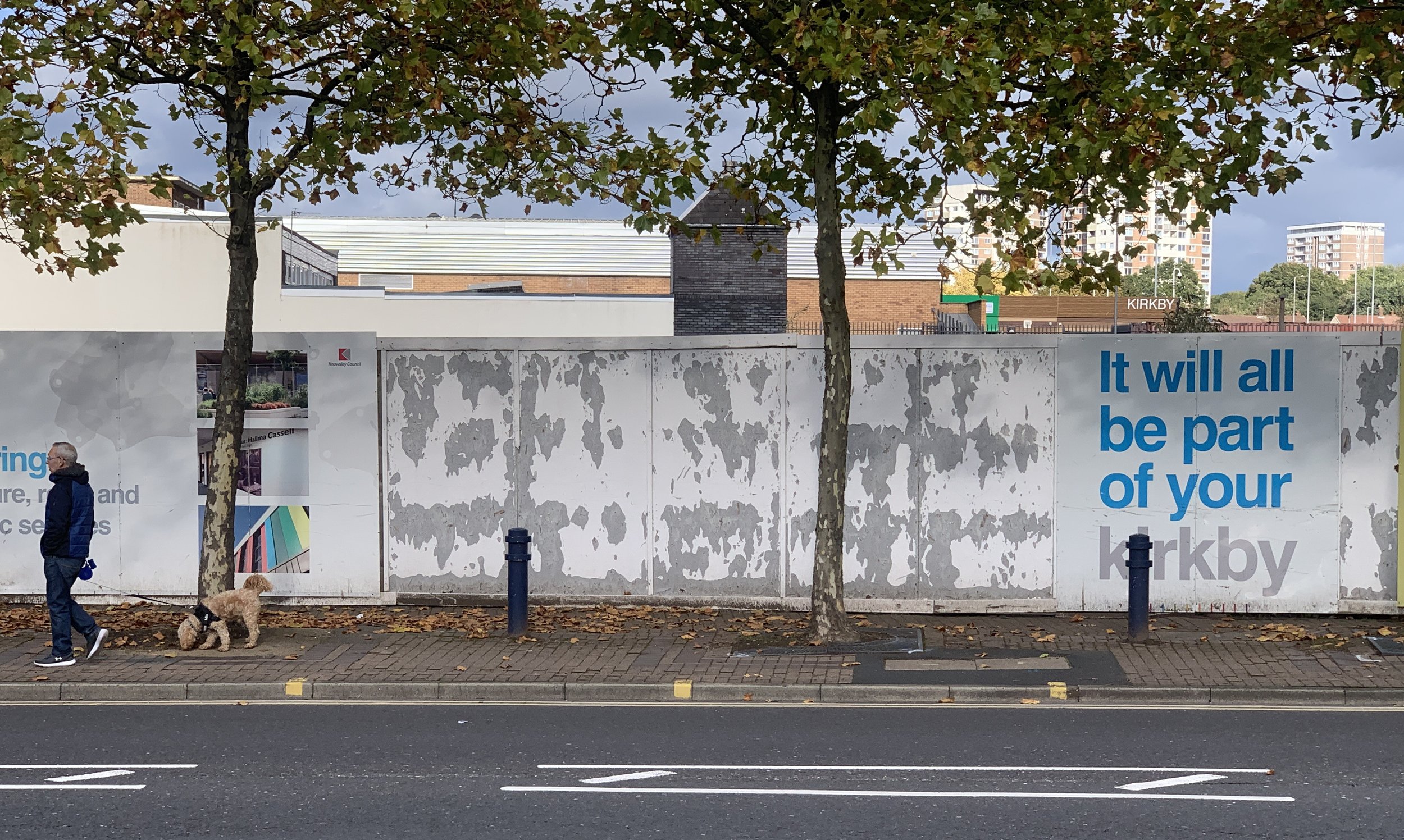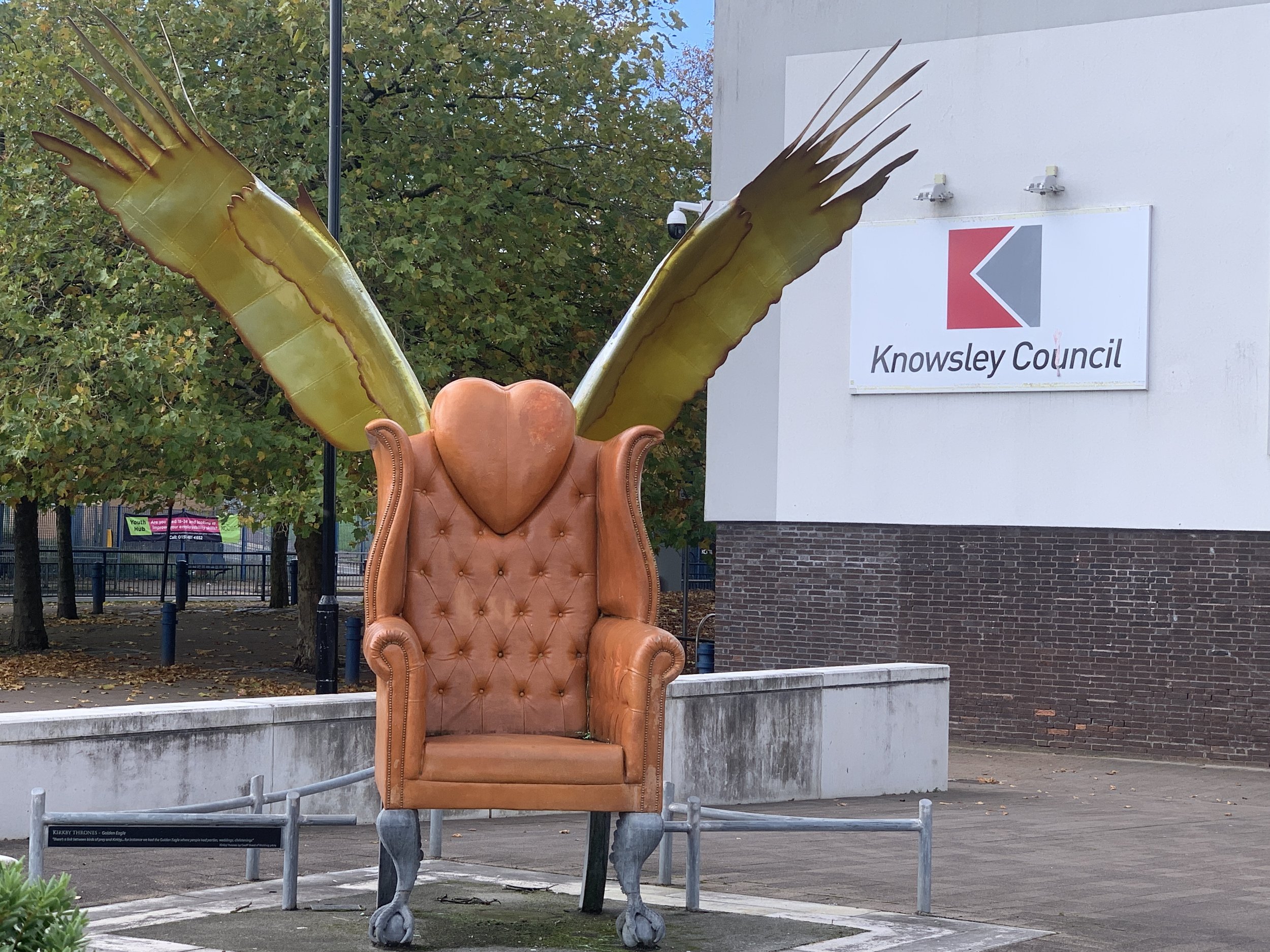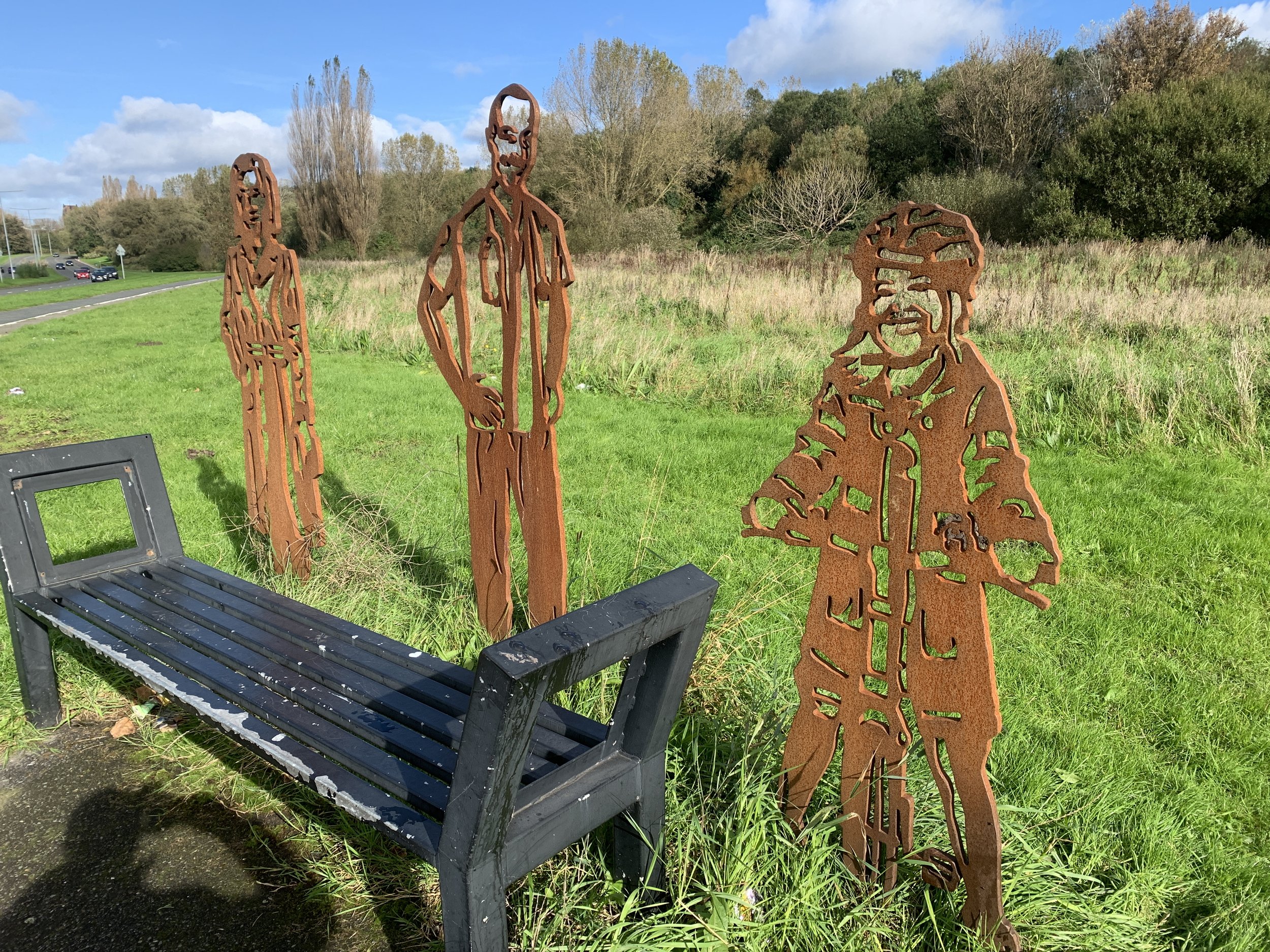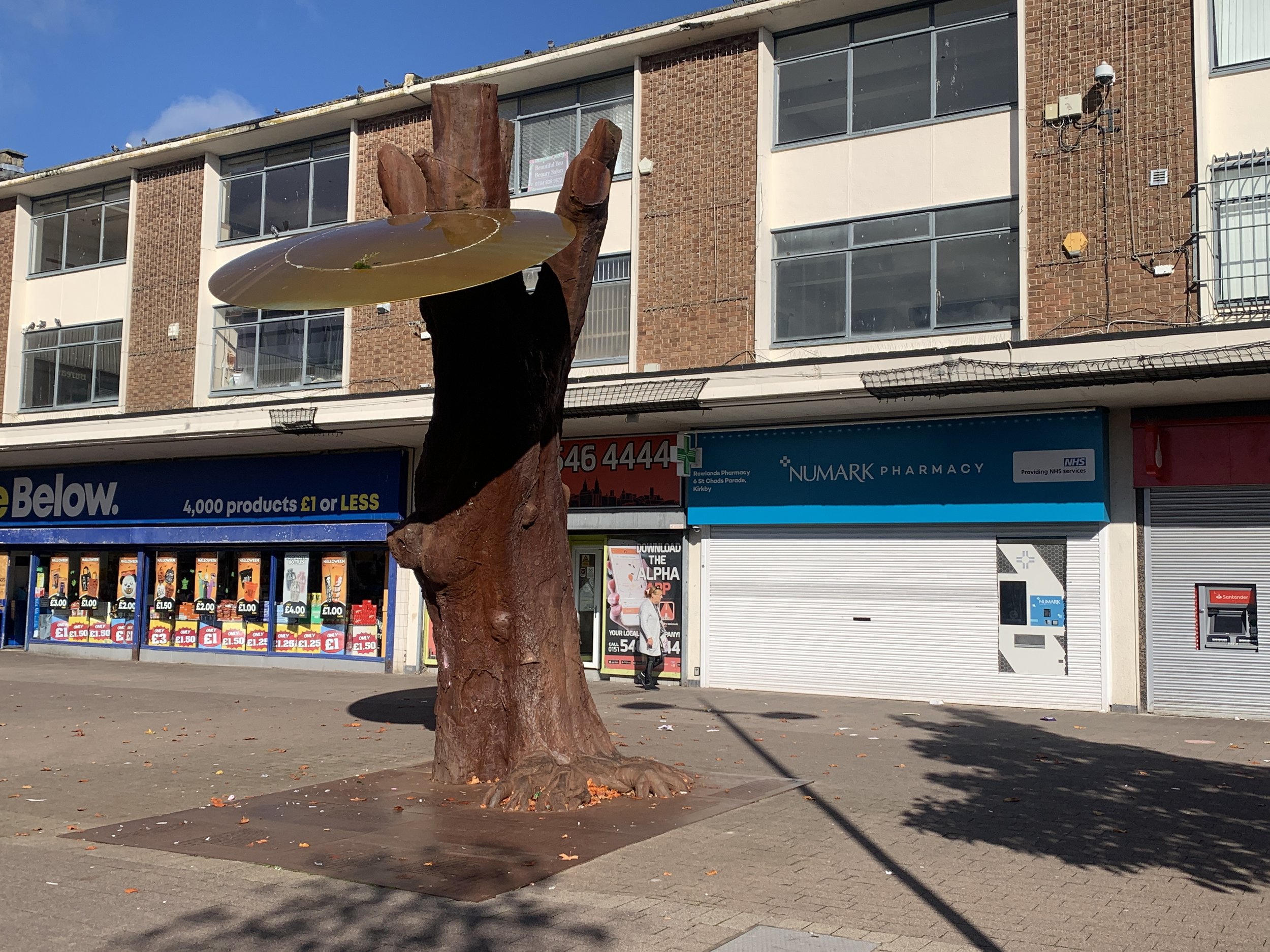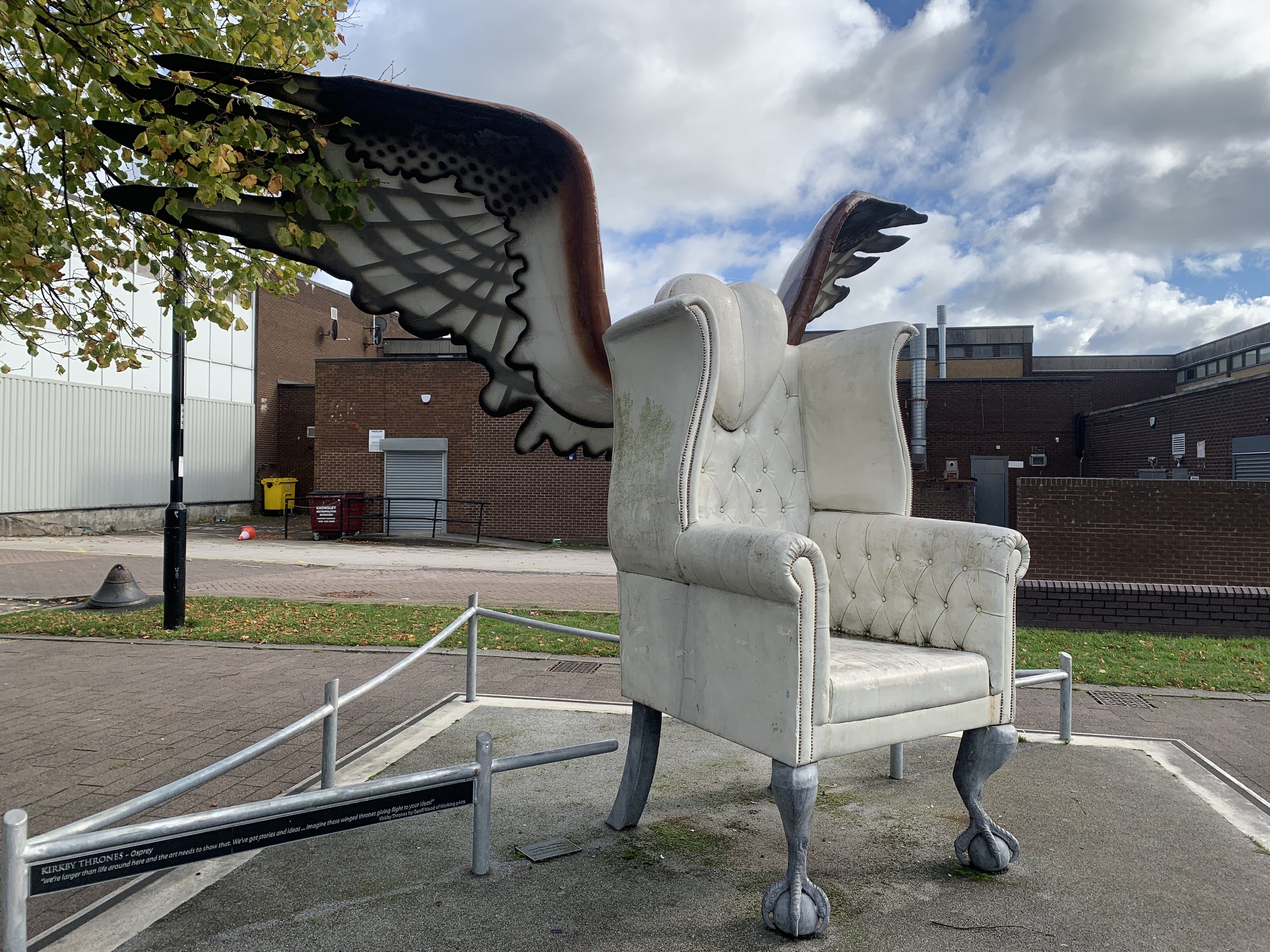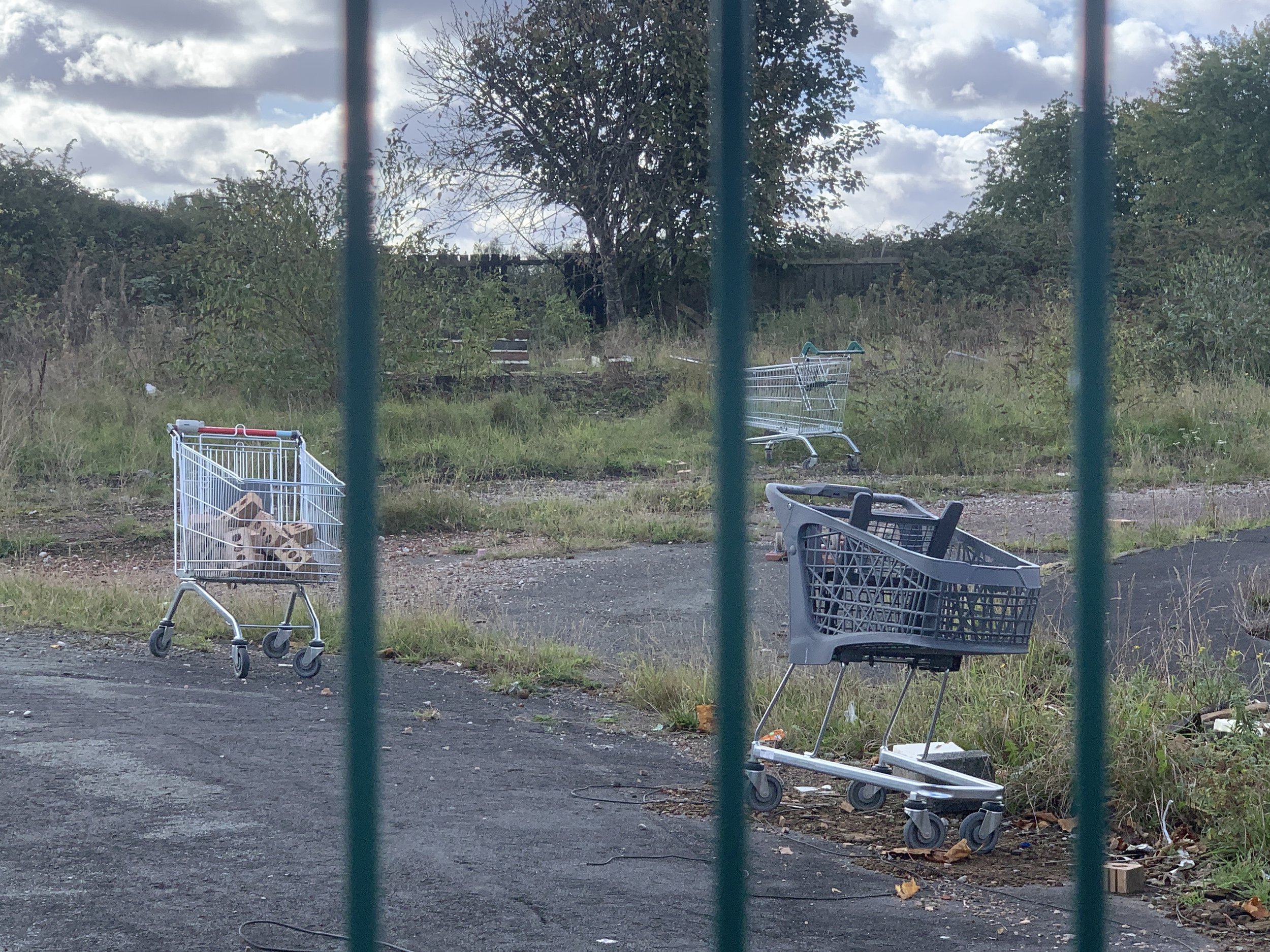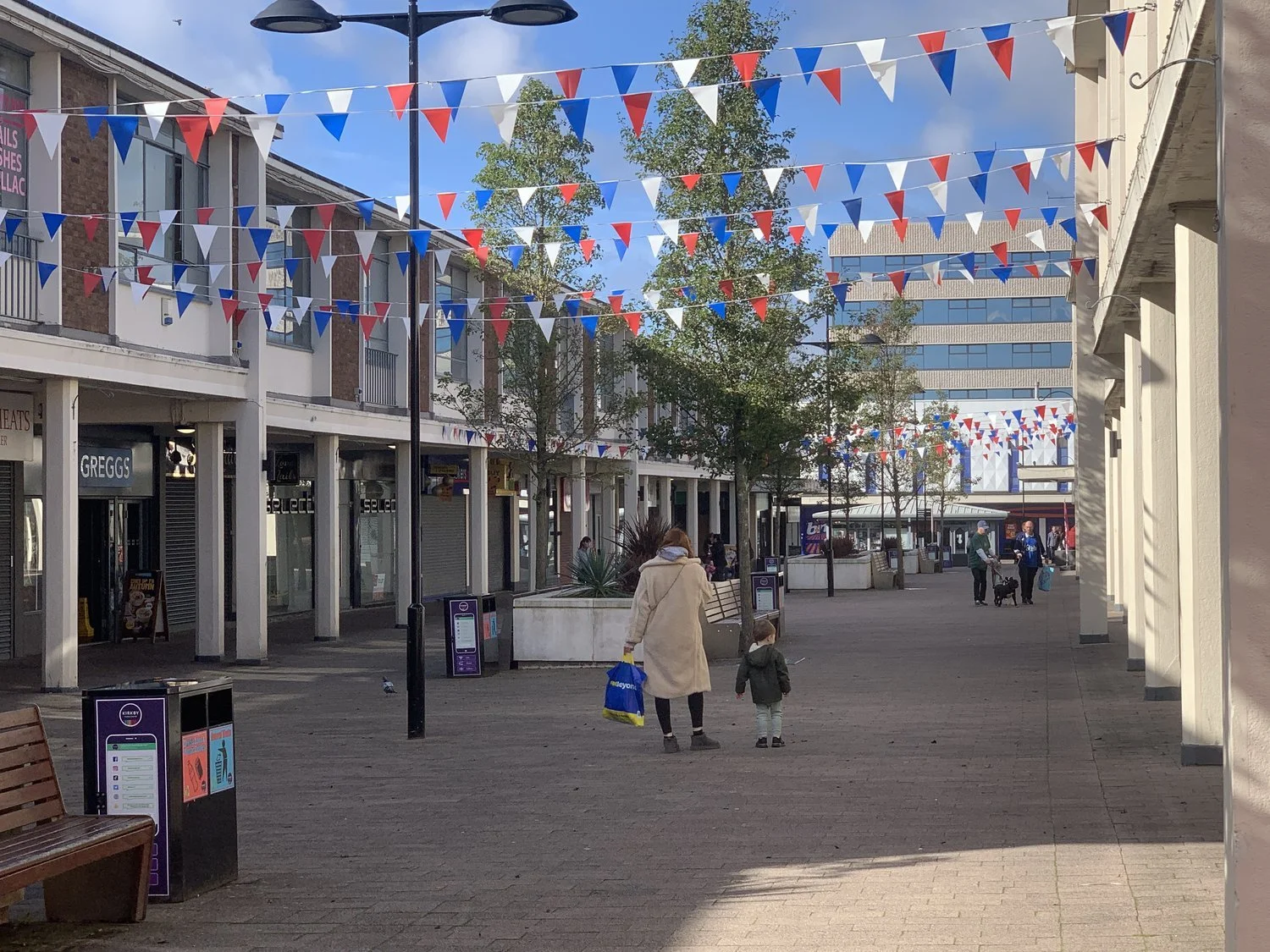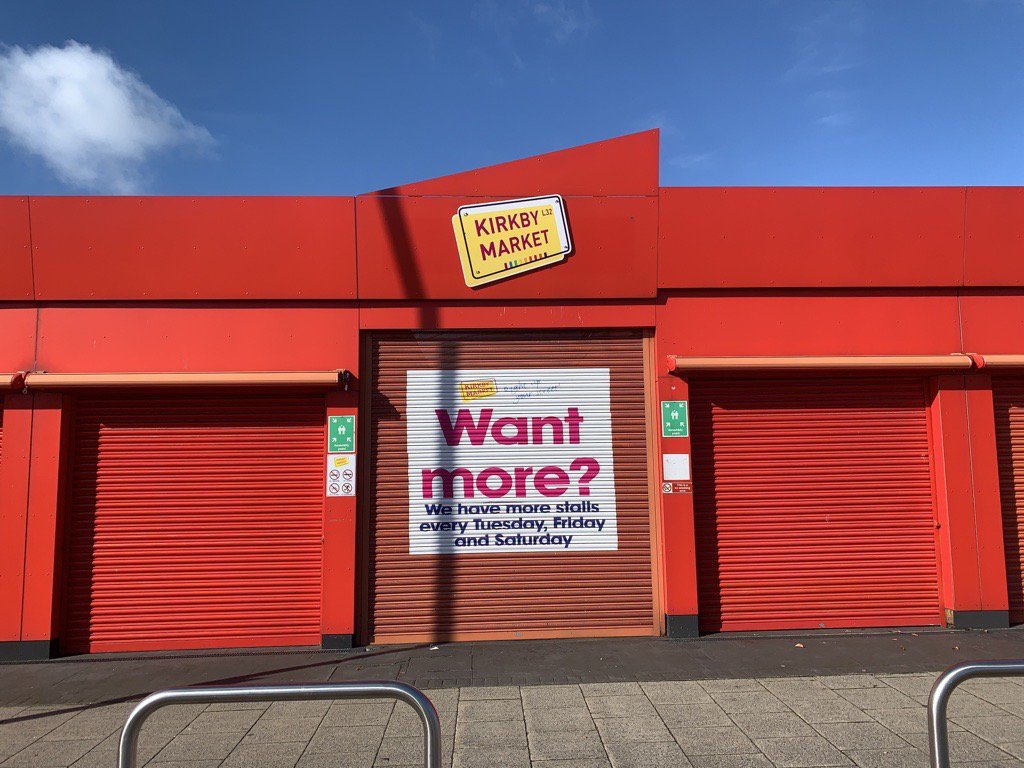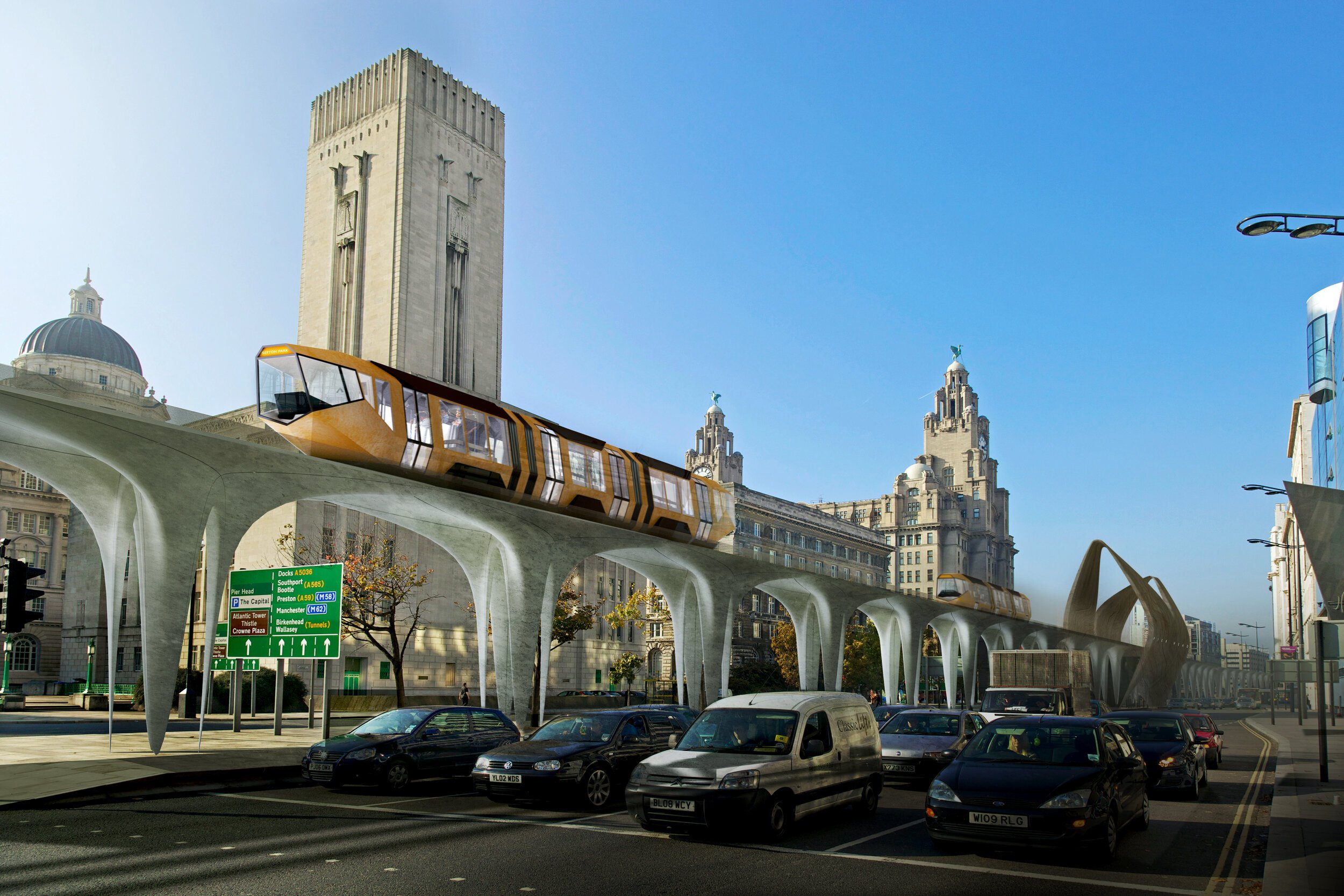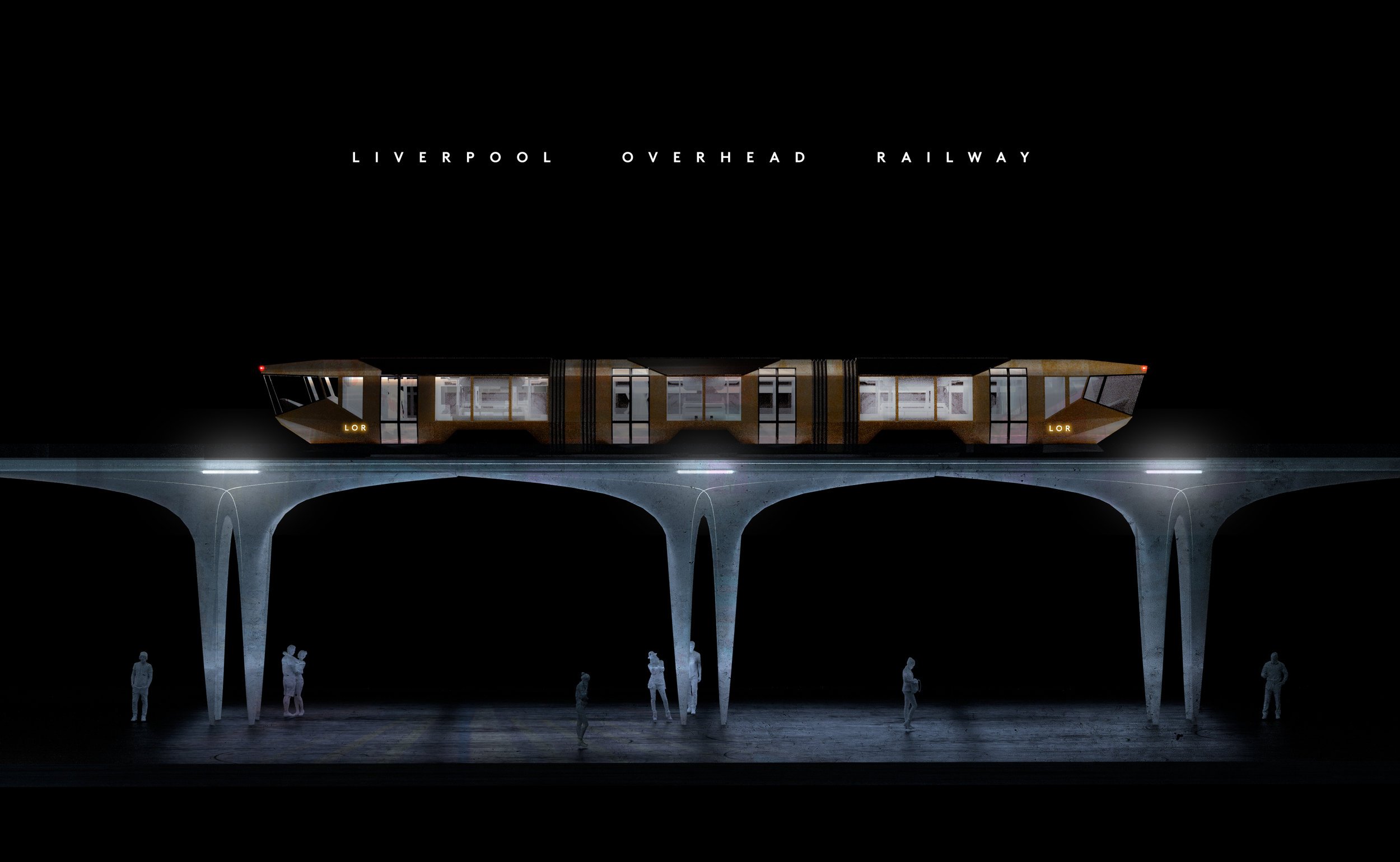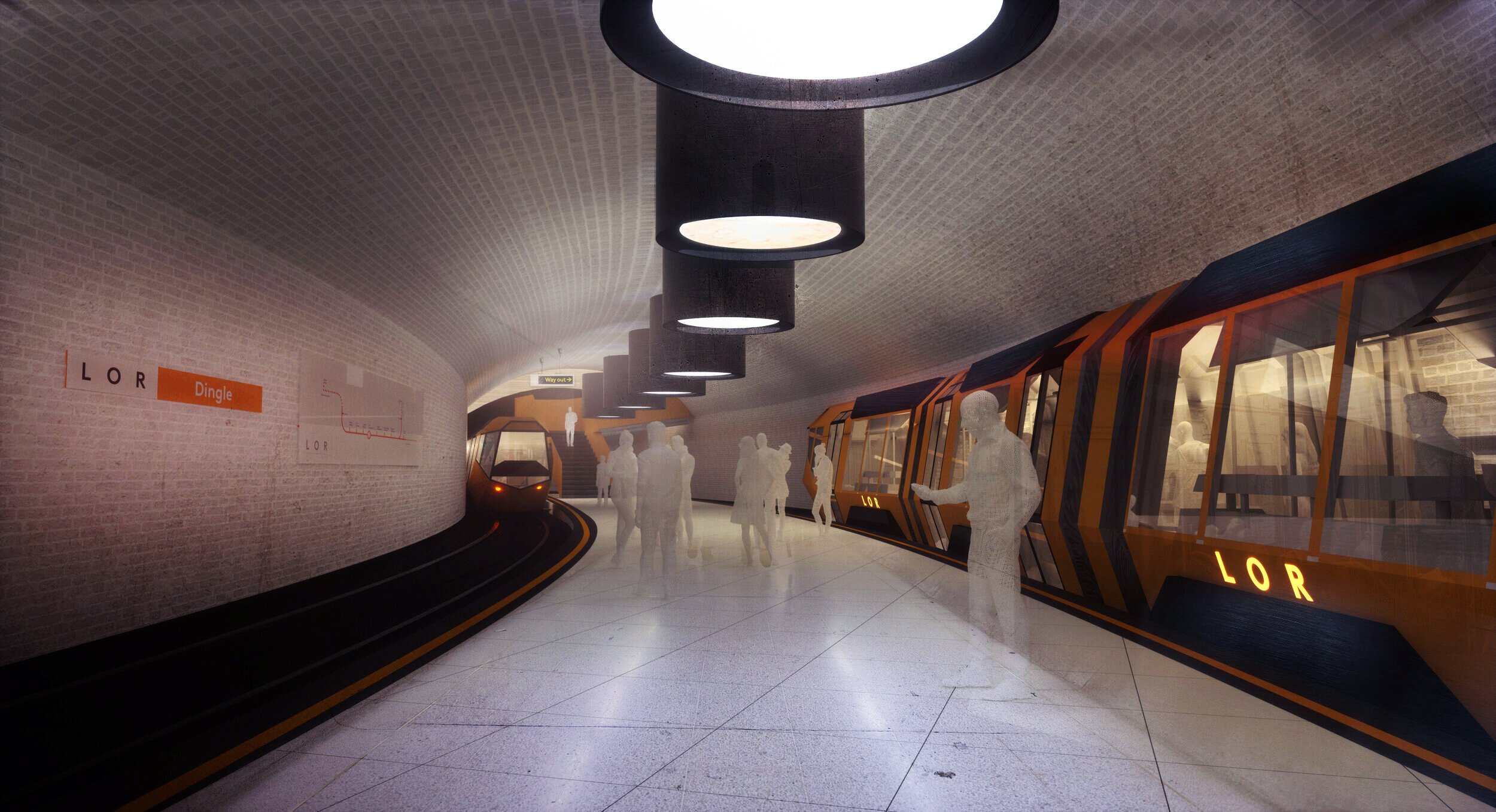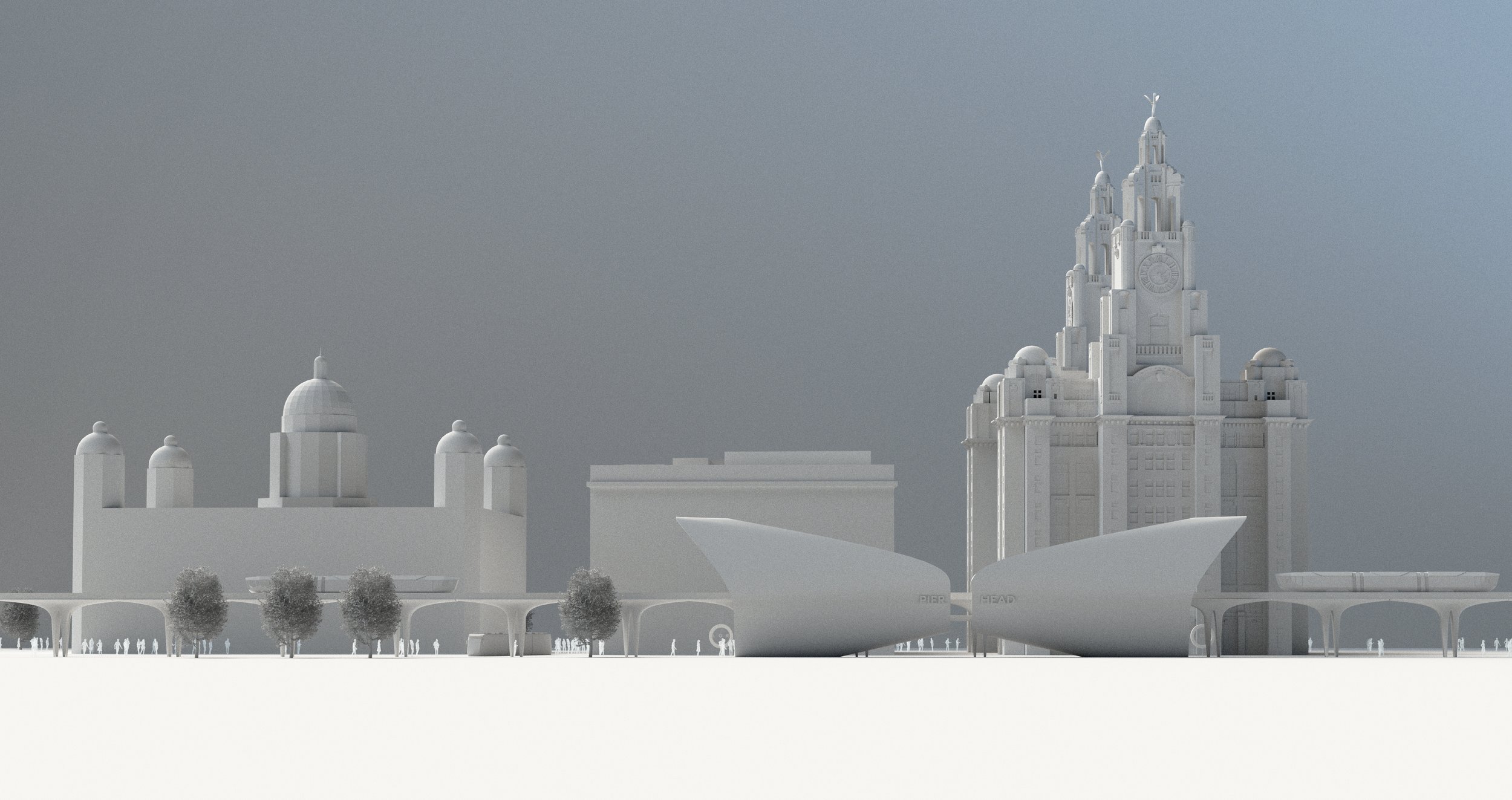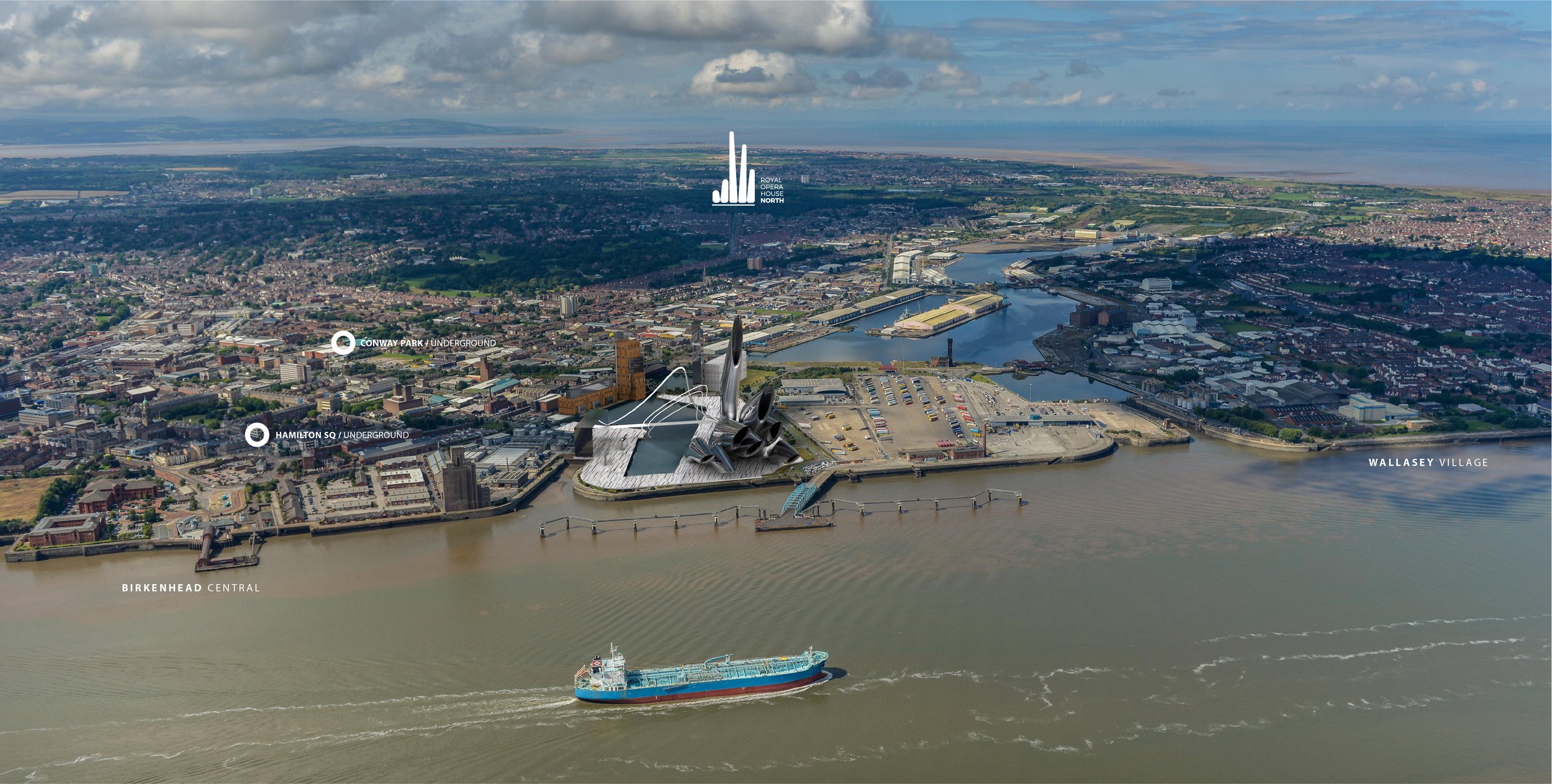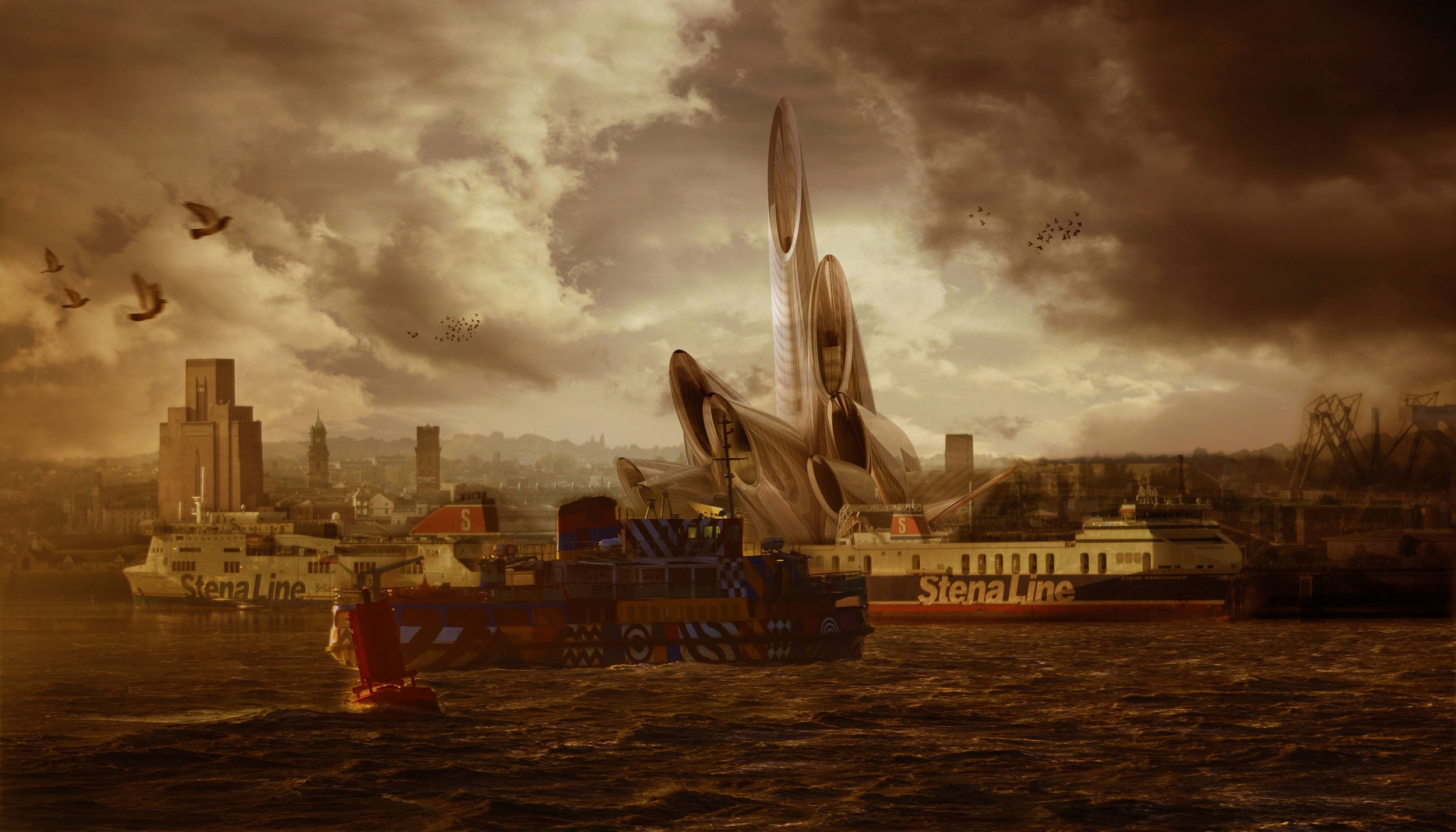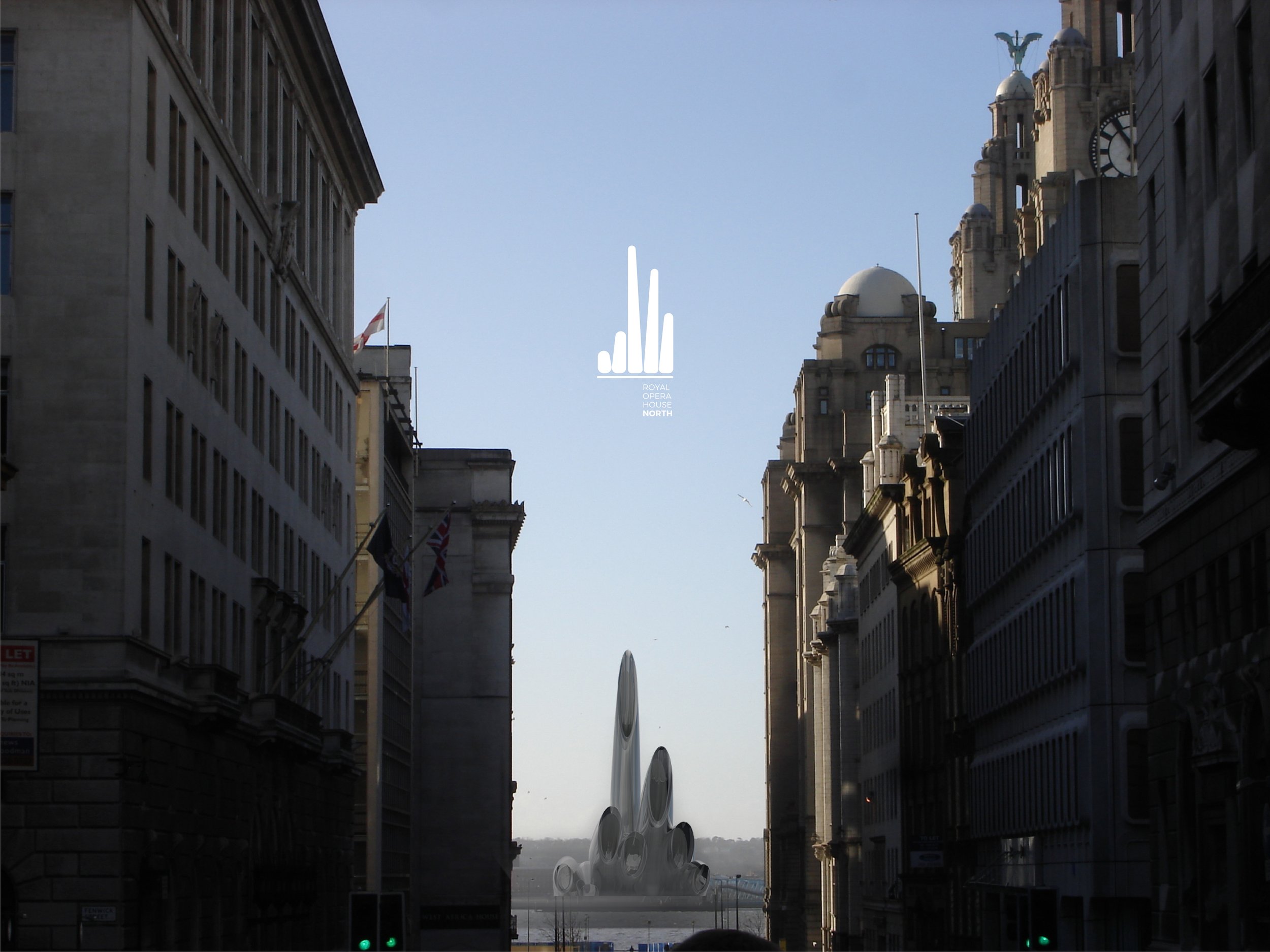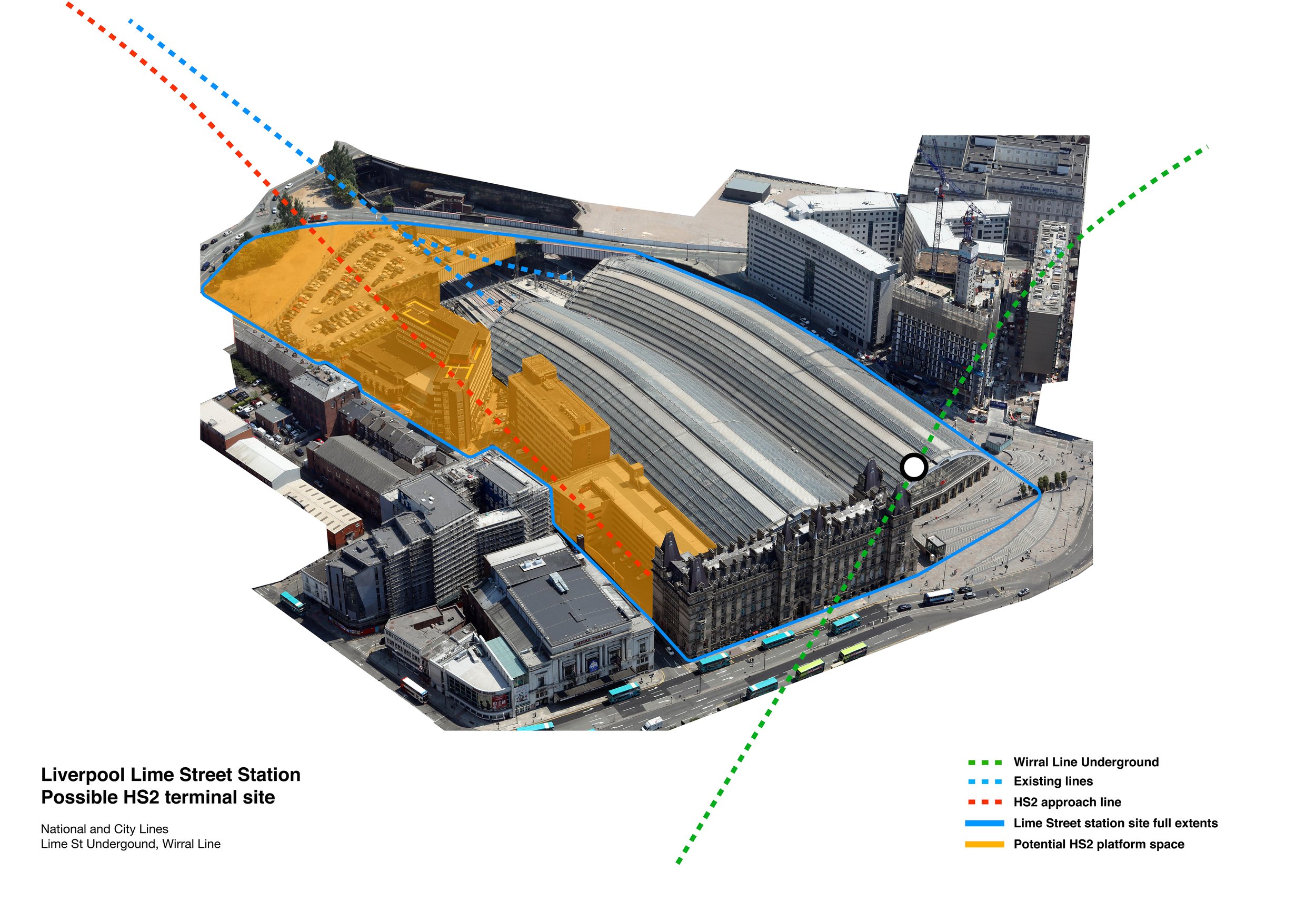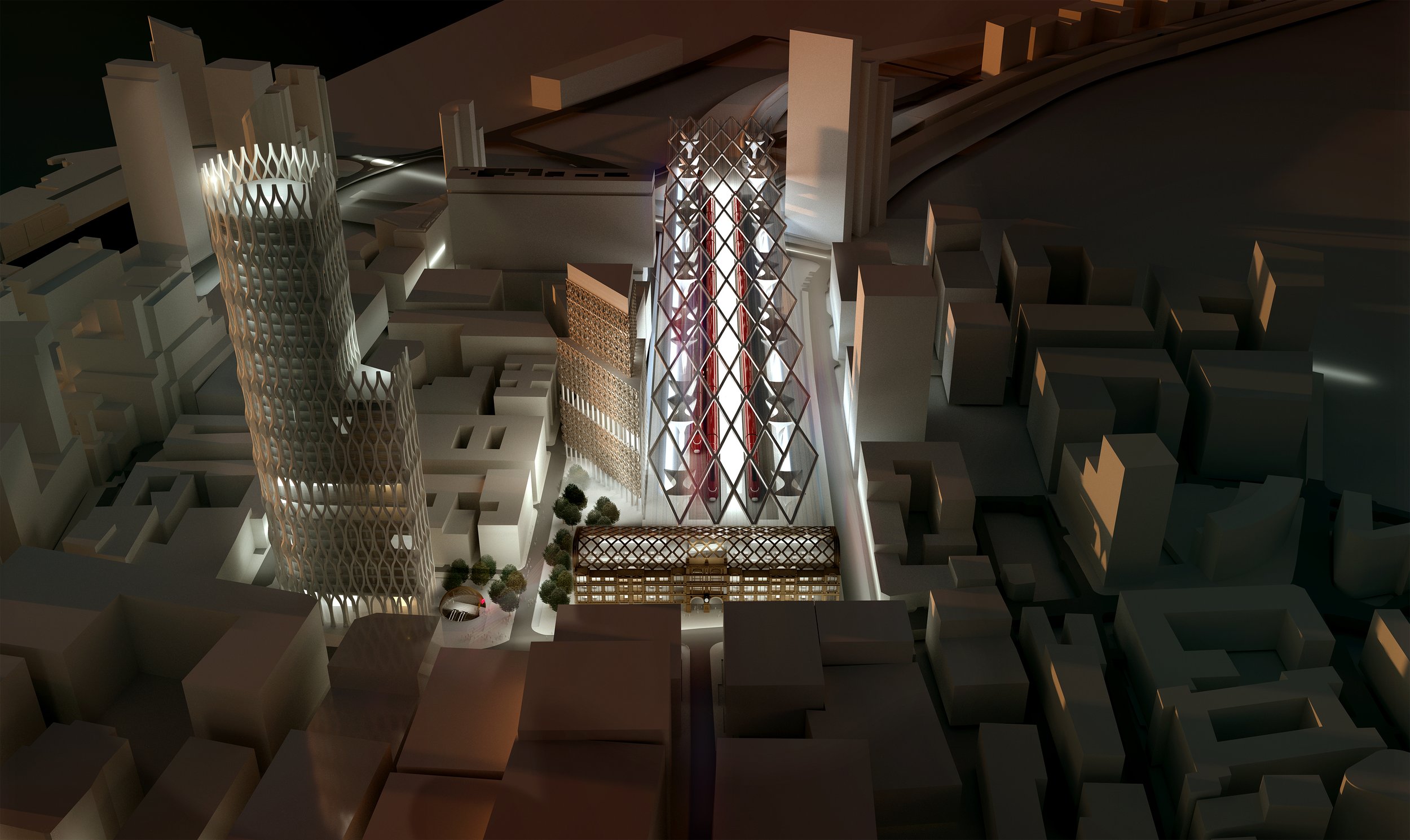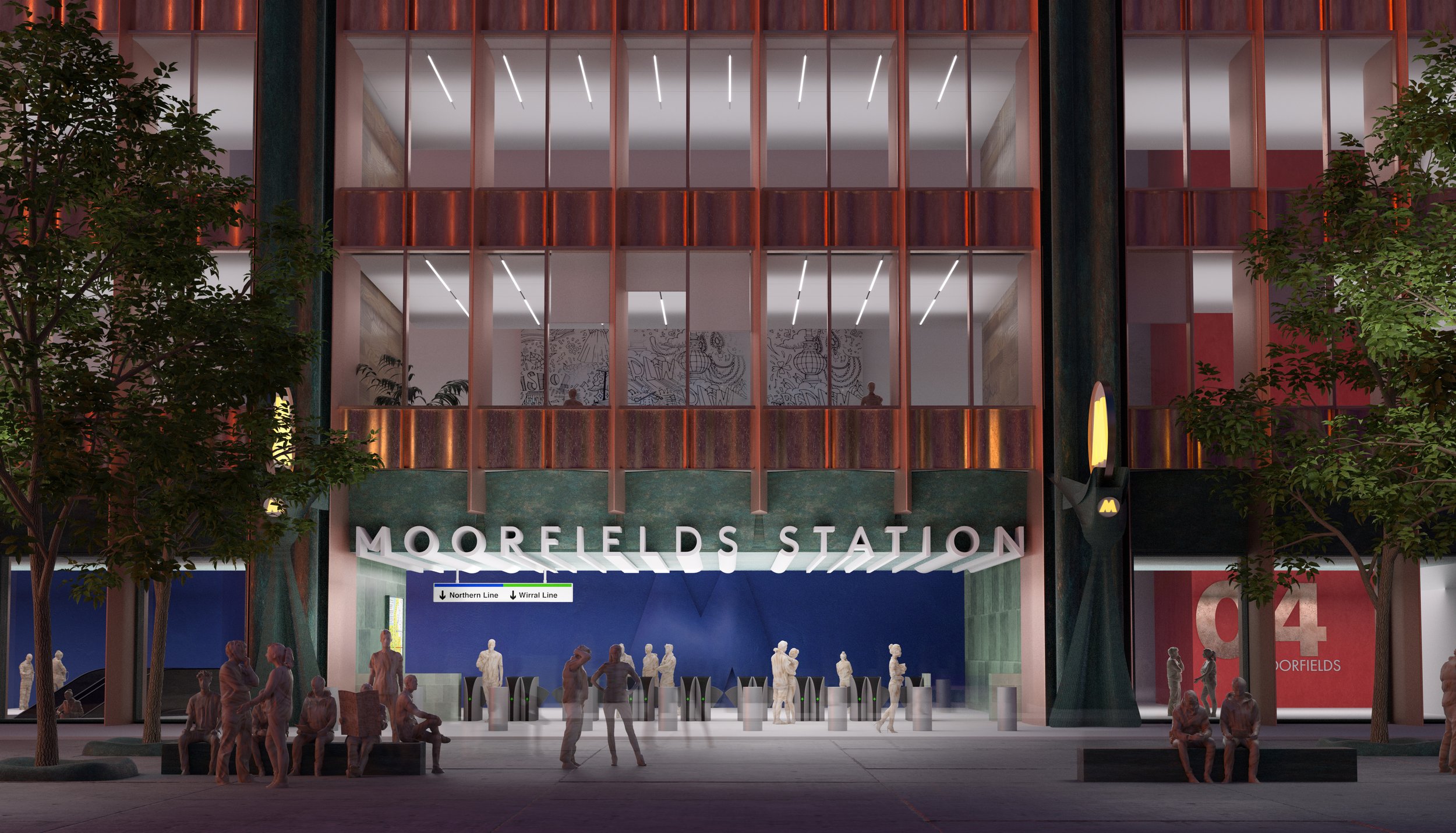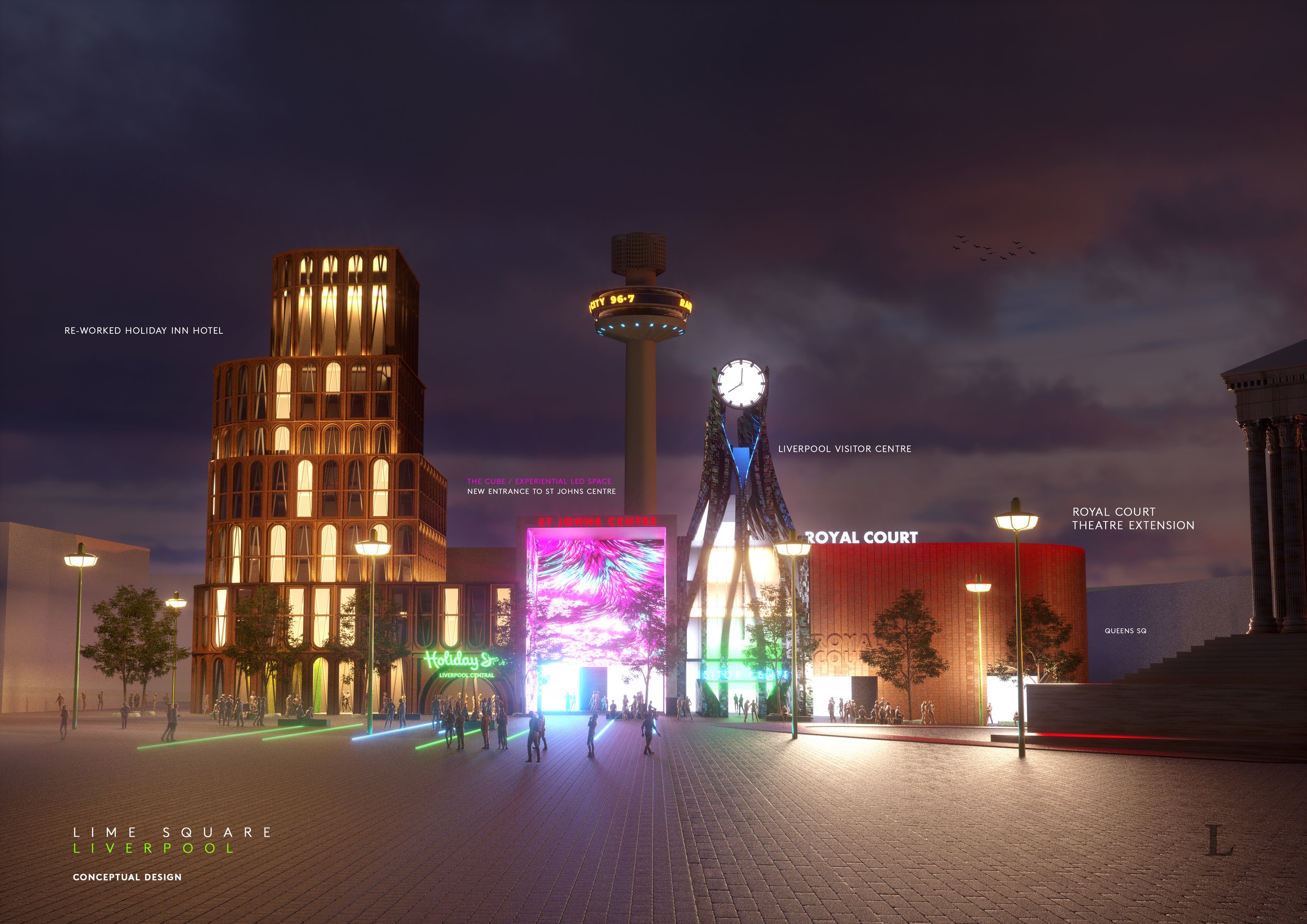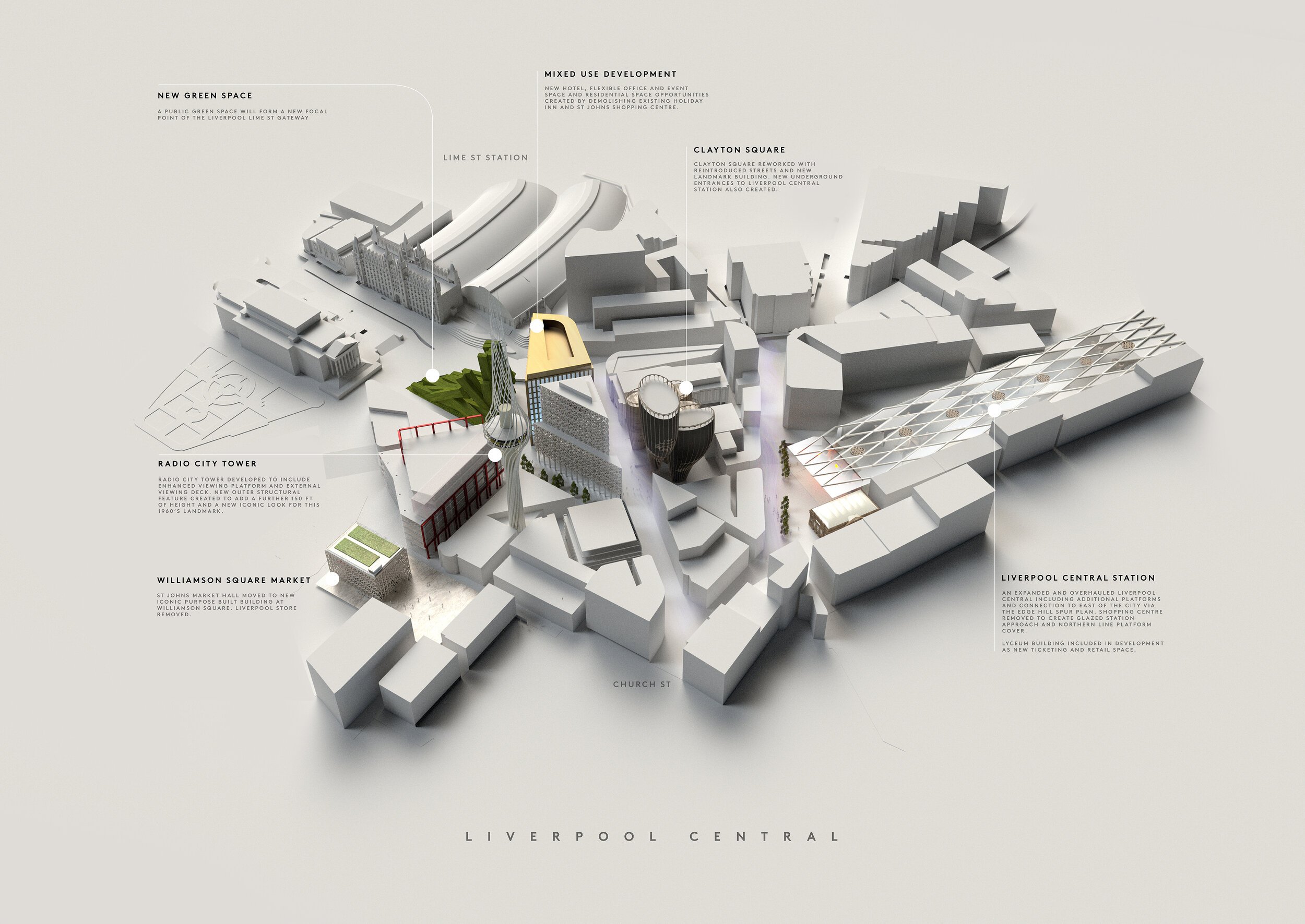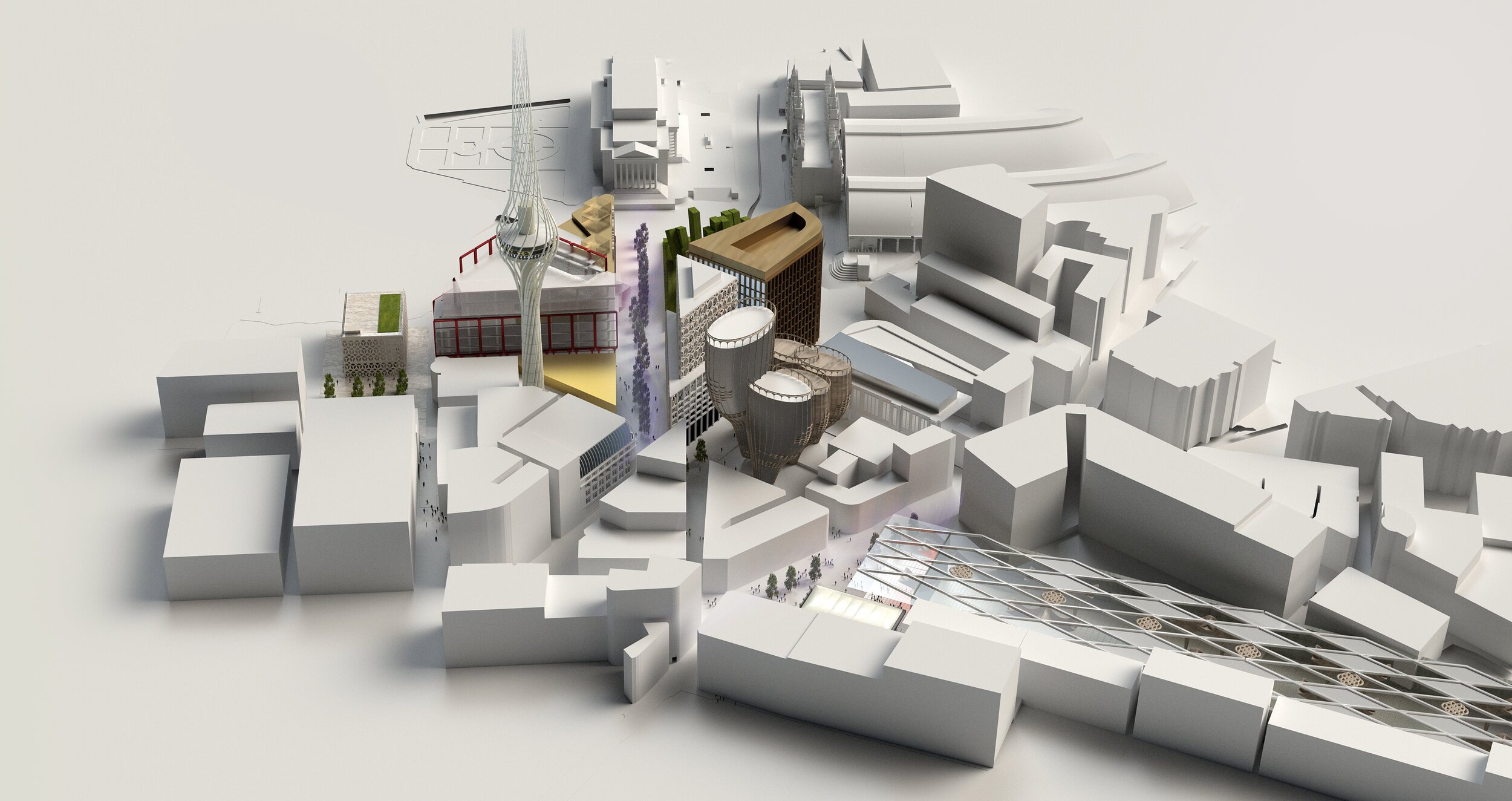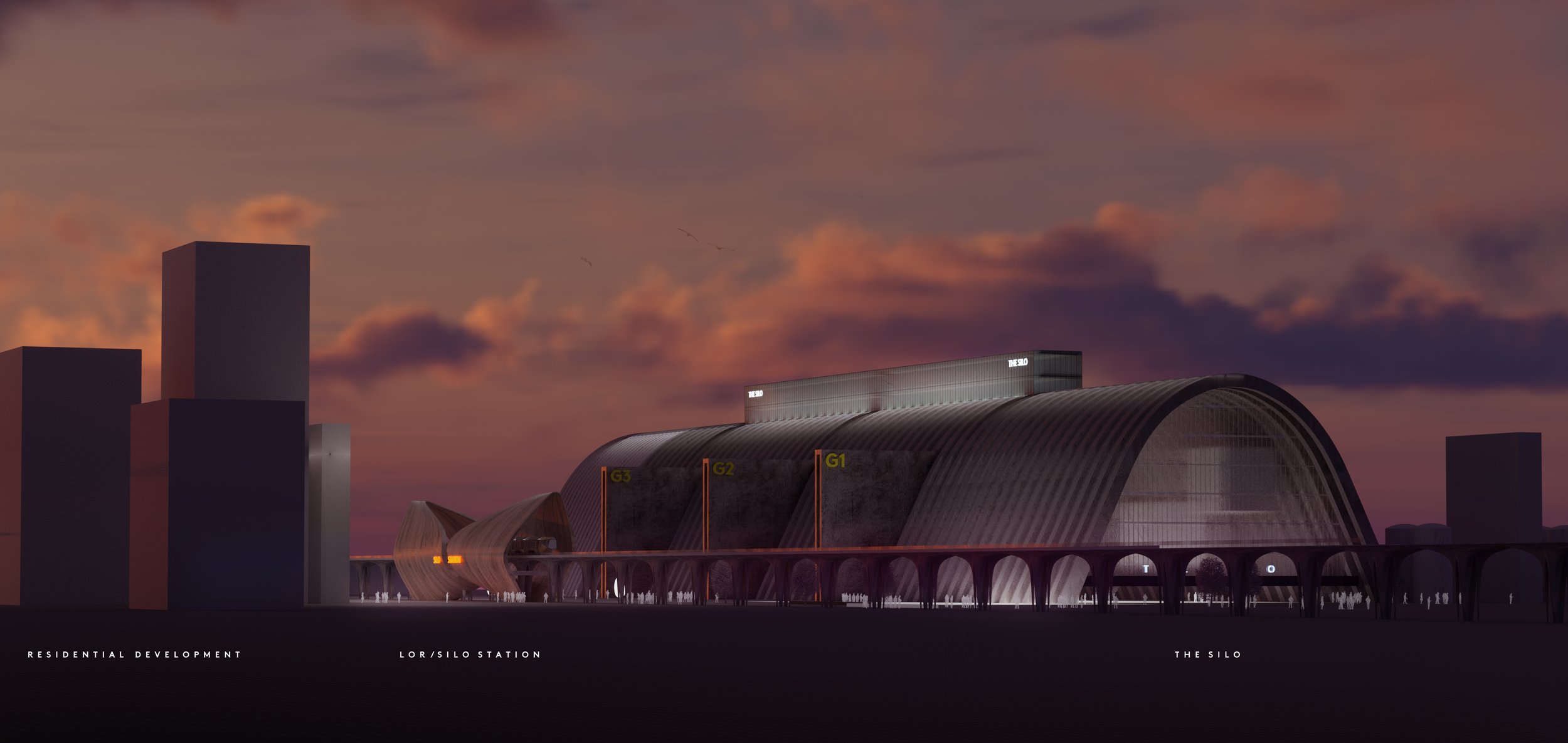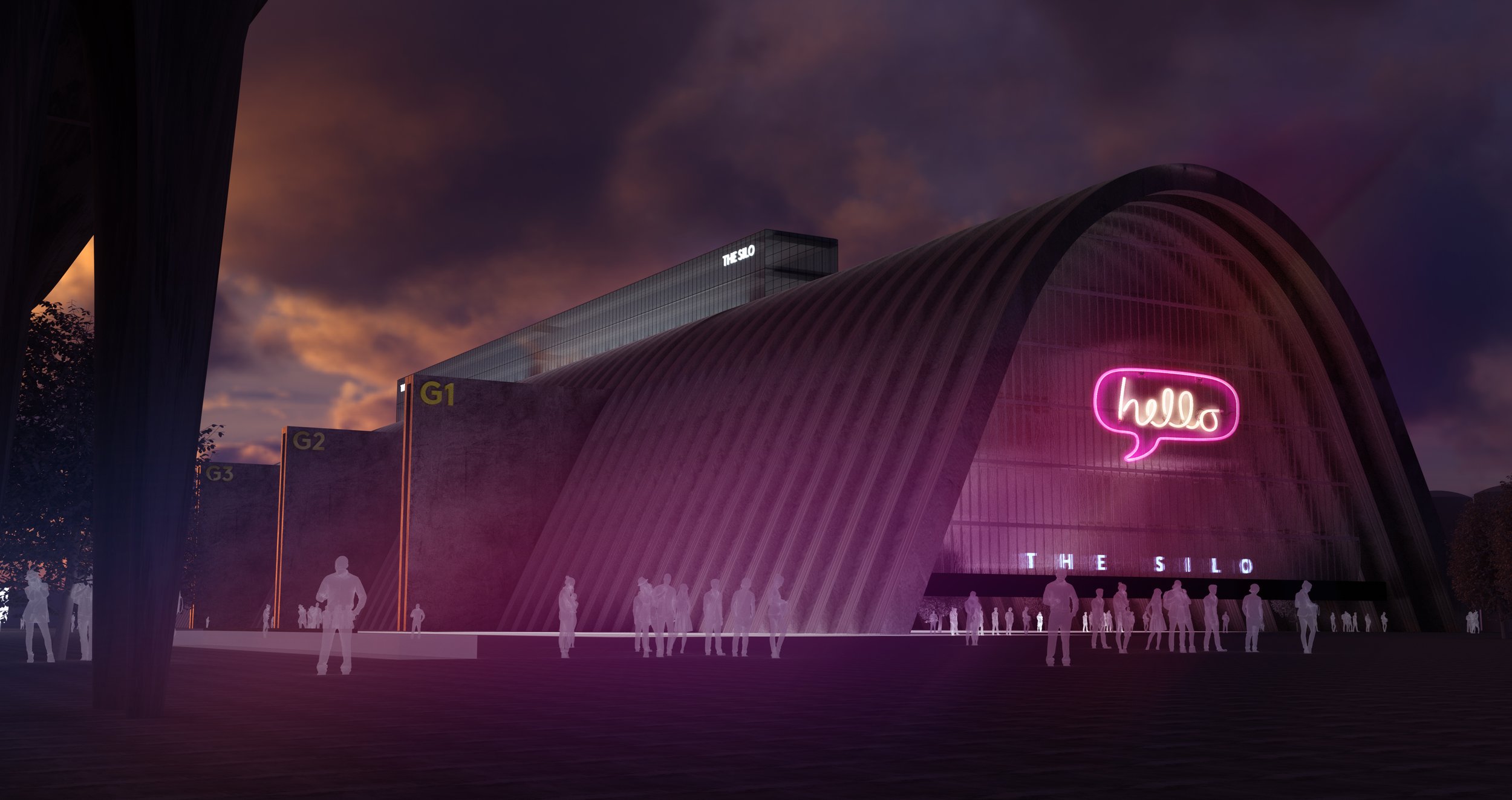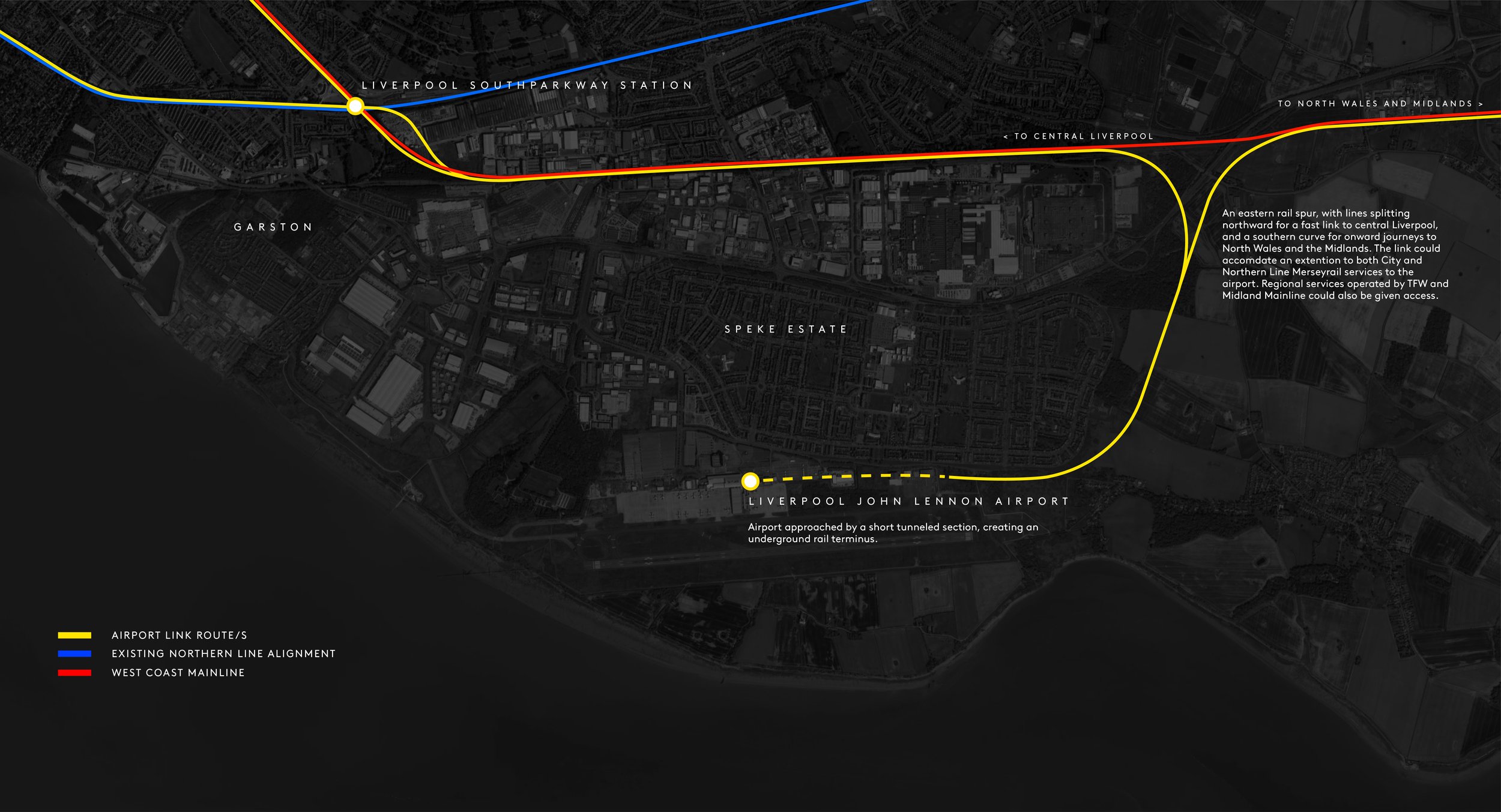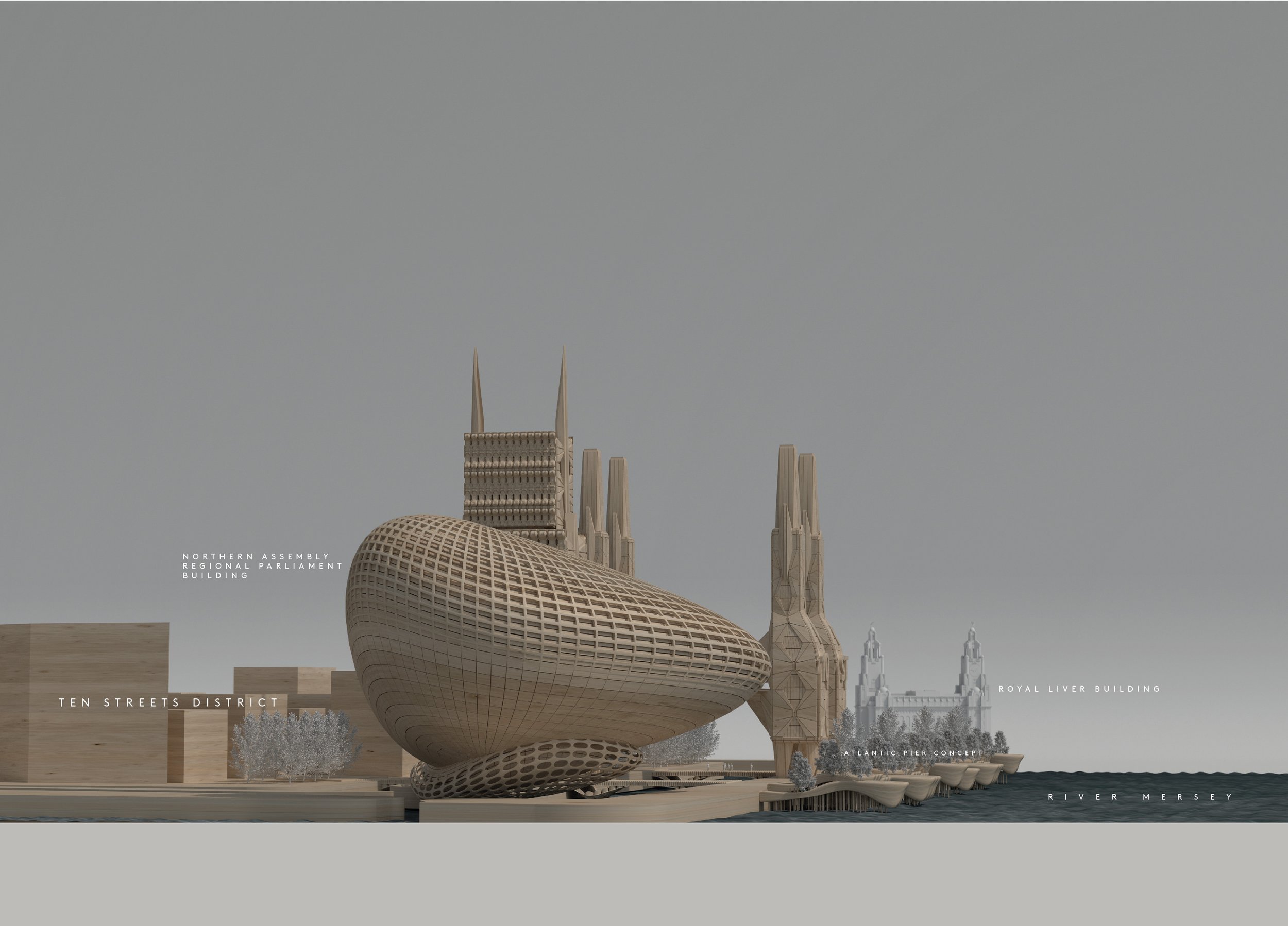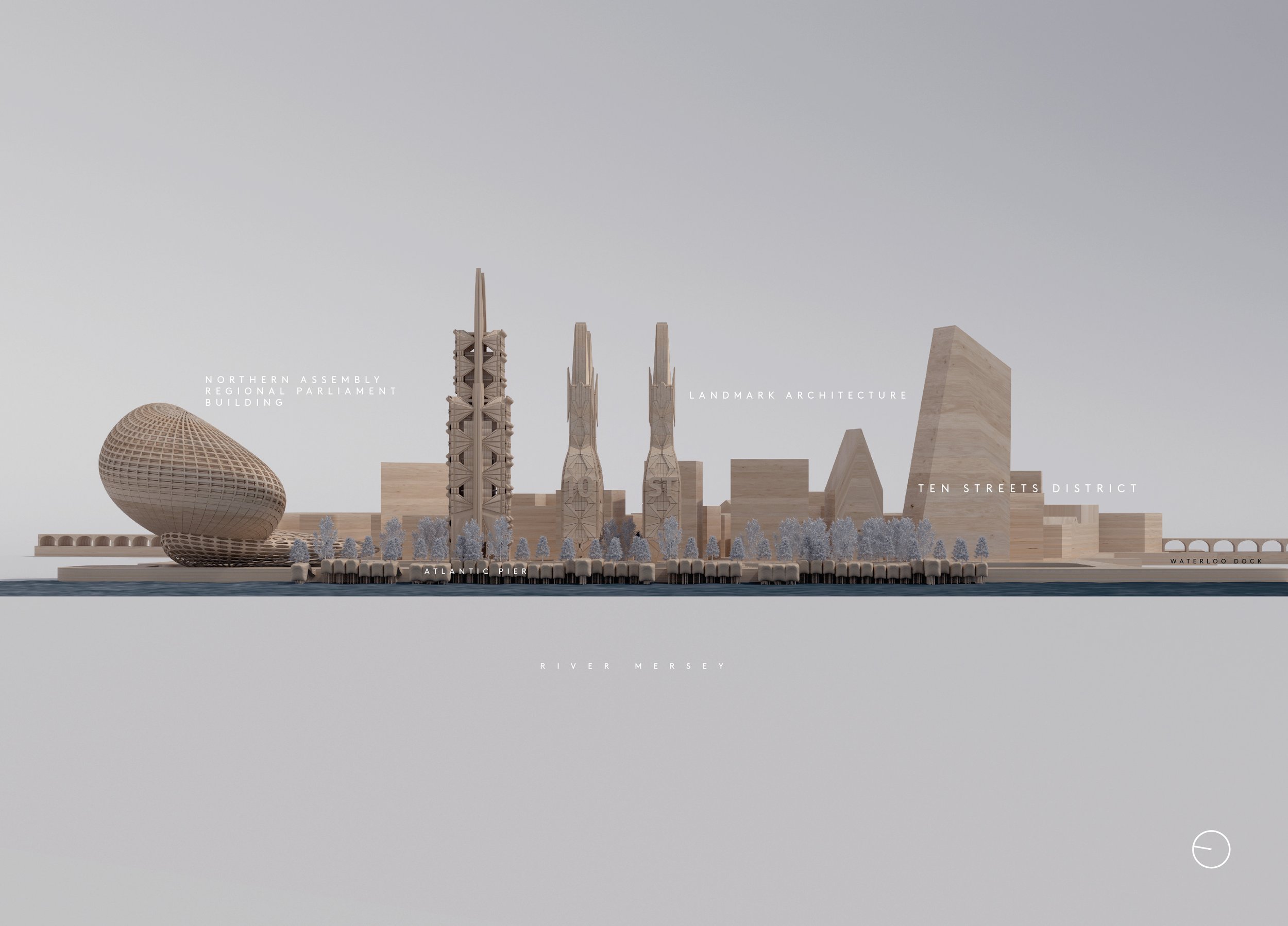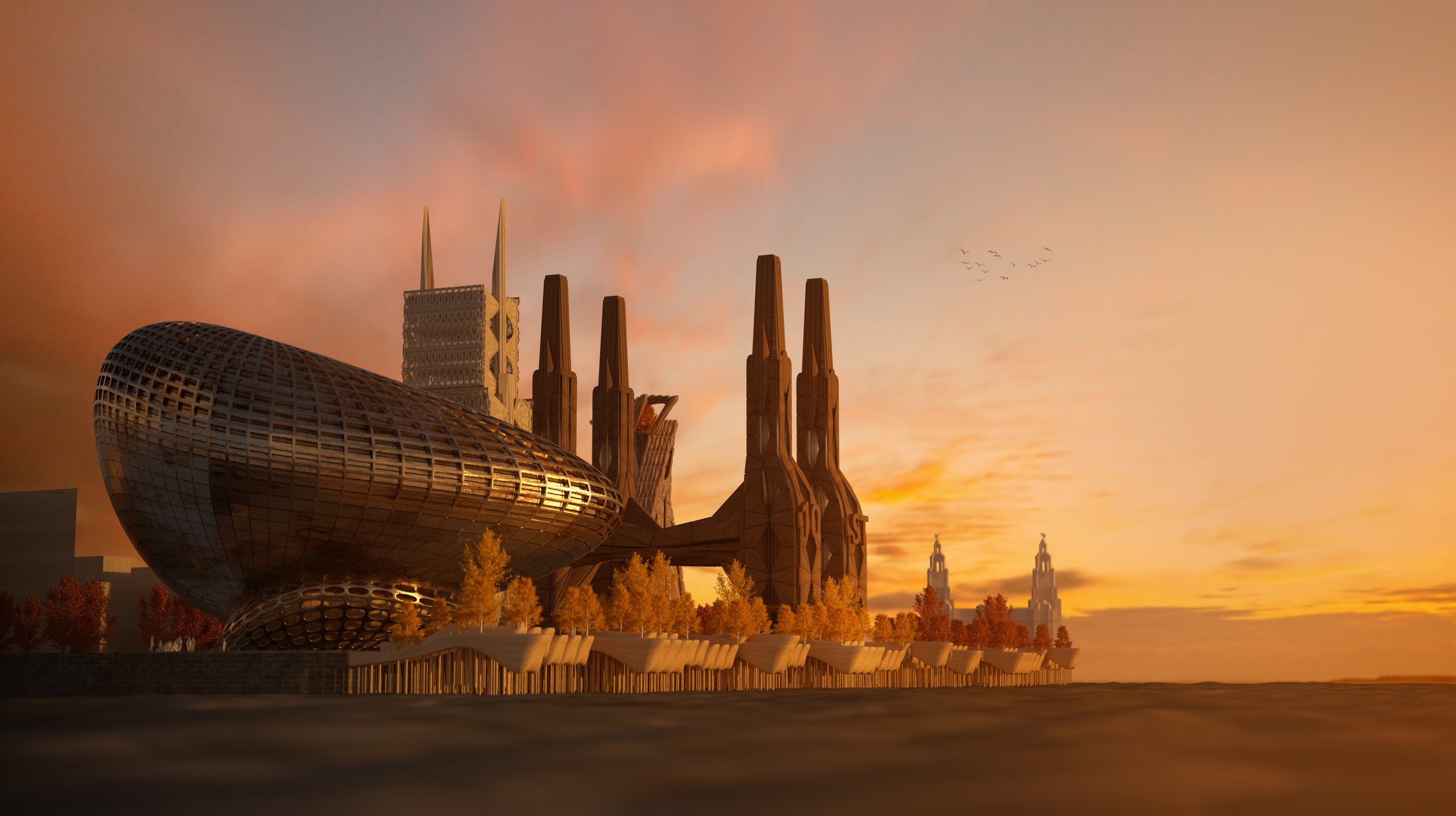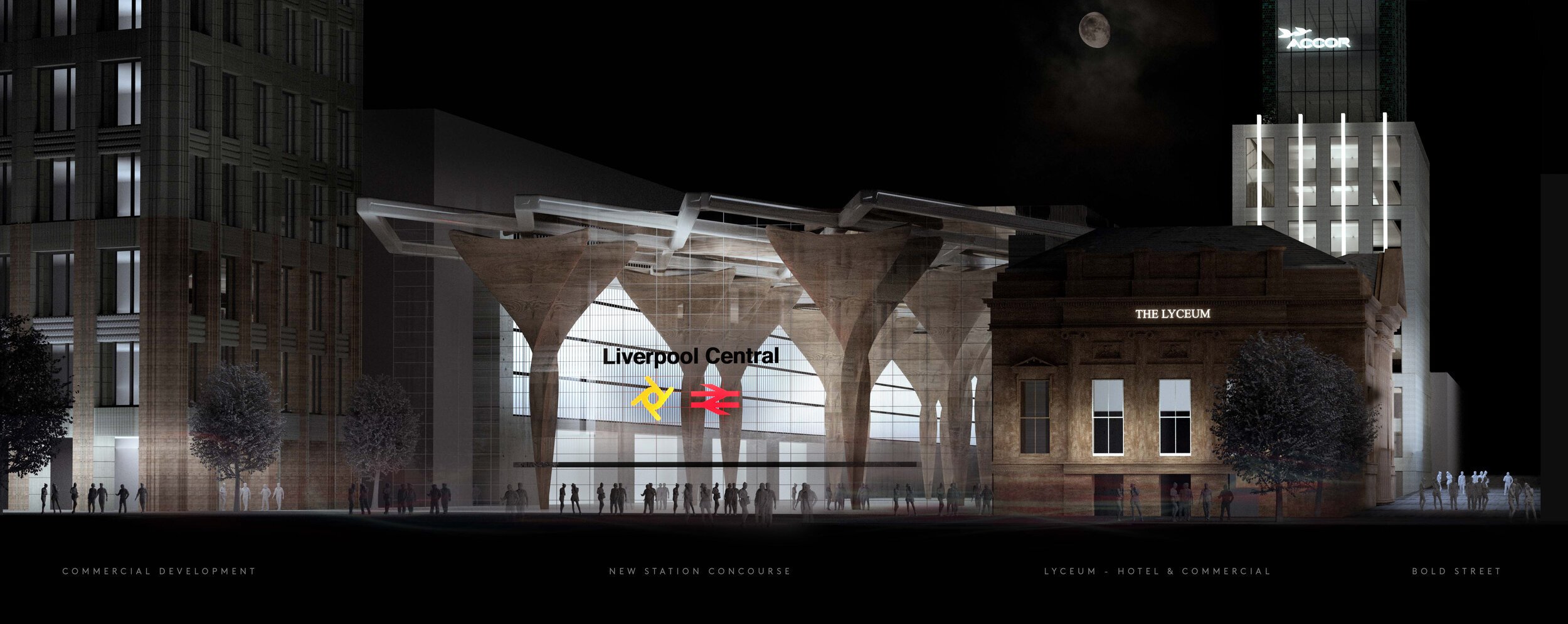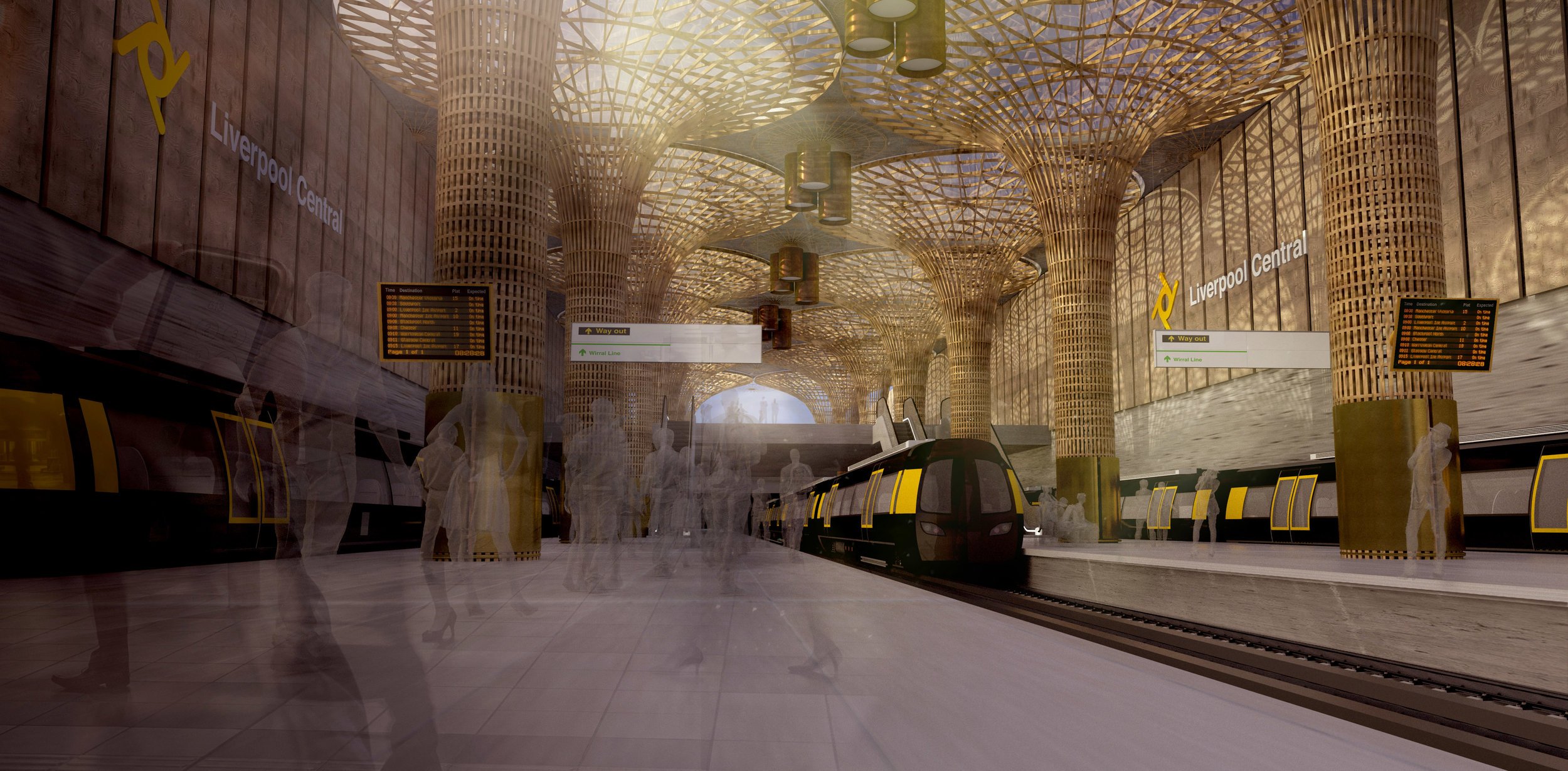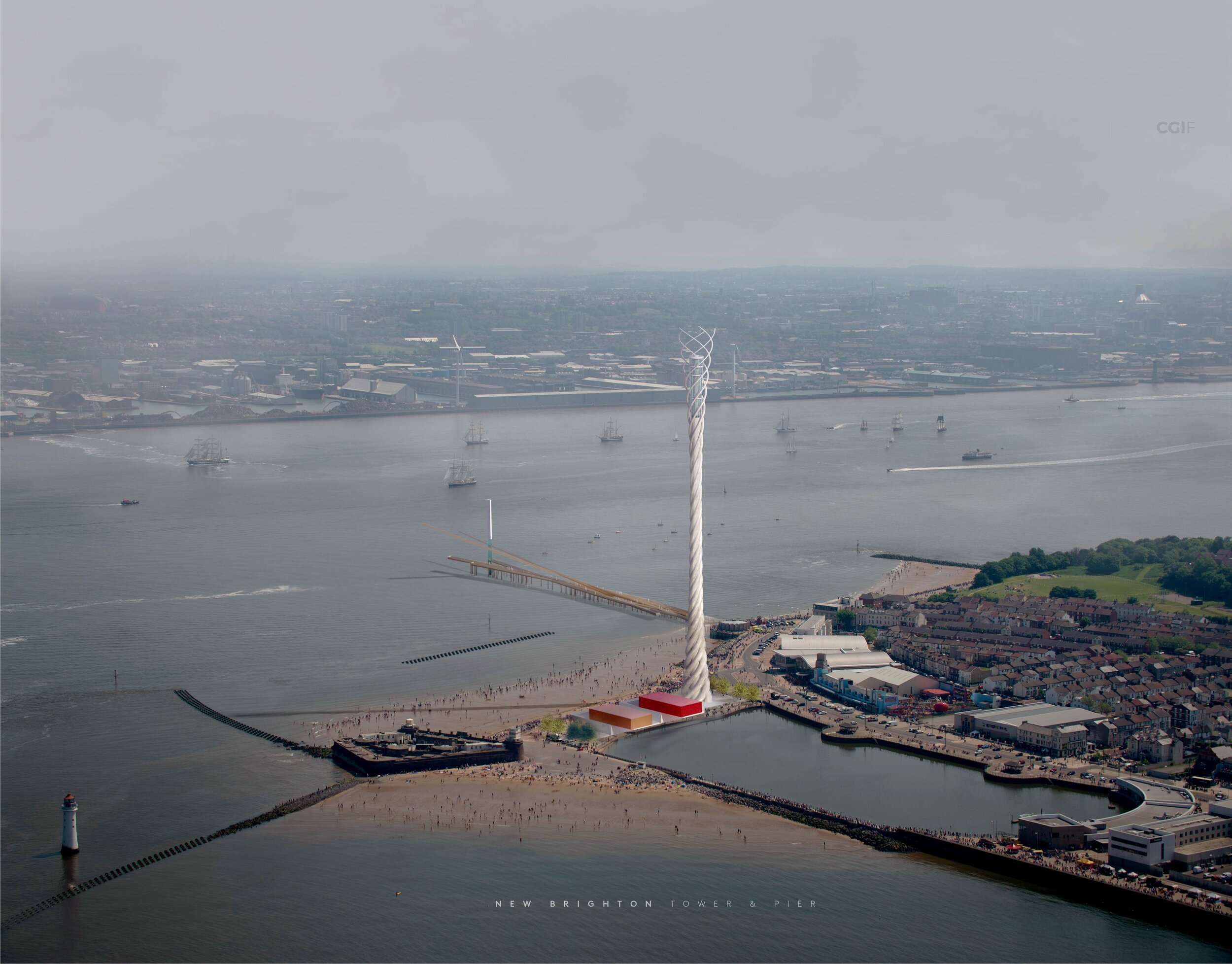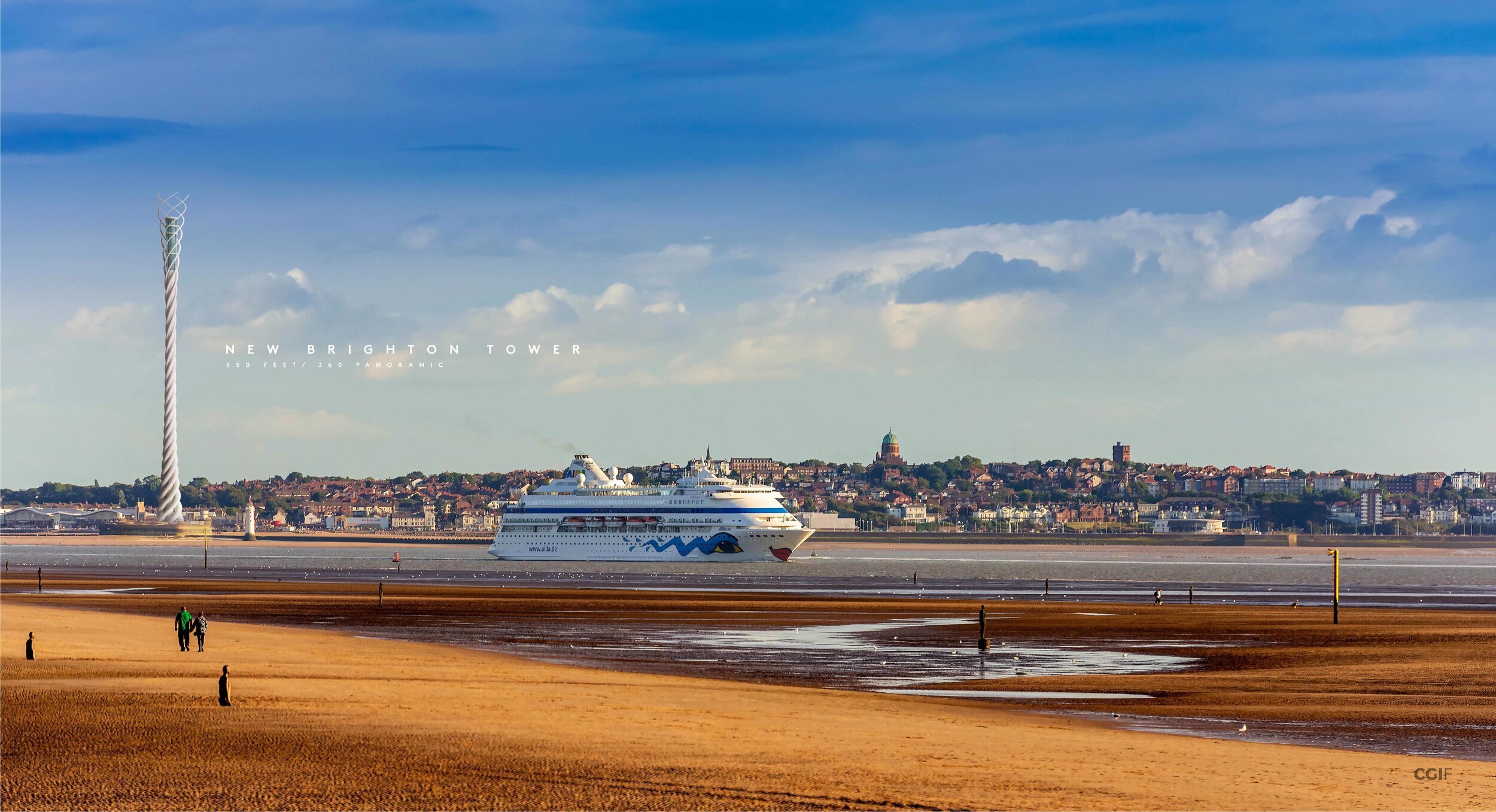Recent features
Genghis Khan, Kirkby Market and me
Since the 1990s, the town of Kirkby, a suburb of Liverpool has undergone a continuous cycle of demolition and reconstruction. The changes, though well intentioned, have largely failed to address Kirkby's social problems or arrest the high rates of deprivation. Regeneration expert, John P. Houghton, who was raised in the town, recounts Kirkby's regeneration history and argues that the social cost of change has often not been worth the price.
John P. Houghton
From rural village to manufacturing powerhouse to struggling suburban overspill, Kirkby has had a chequered history. Just 6 miles from Liverpool, in the borough of Knowsley, the town was once the inspiration for the TV show Z-Cars, a police procedural majoring on social realism in gritty estates.
In recent years, Kirkby has seen some degree of investment, from new housing and schools to a brand new market and health centre, and it recently acquired a new train station. Artwork is layered around the town’s centre including winged chairs and a wise, old elephant riding a Viking longboat. But the picture remains mixed. Hope for better rubs shoulders with as yet unfulfilled promises, marked by peeling hoardings and discarded shopping trolleys. The one thing you can say for sure is that Kirkby is increasingly unrecognisable, with planners consistently favouring demolition and rebuild over subtler forms of intervention.
One man who would know is John P. Houghton, a regeneration expert who grew up in the town. In this article, he argues that the hard lessons from Kirkby’s past need to be applied to its future - that people should come before property. John believes keeping communities together and repairing the social fabric is better than constantly demolishing and rebuilding estates…
In the year 1218, the Shah of Khwarezmia made one of the worst decisions in all of human history; he picked a fight with Genghis Khan.
The Mongol leader had made a tentative peace-with-trade offer to the Shah, the ruler of a vast Central Asian empire, by sending a caravan of ambassadors to negotiate an agreement that would allow both medieval superpowers to co-exist. In response, the Shah killed the emissaries. Khan was so enraged by this act of provocation, he immediately declared war on the Khwarezmian empire and its unwise leader. Victory on the battlefield was swift, although the Shah himself escaped and fled.
Without his enemy’s body for proof of his conquest, Khan ordered his men to the Shah’s hometown, where they demolished and dismantled every single building until no structure was left standing. Even this was not enough to satisfy Khan’s desire for retribution.
His troops went on to re-direct a local river through the place where the town once stood, washing away the last stumps of human settlement and wiping the Shah’s birthplace from the map.
While the course of Merseyside’s River Alt is probably safe, I sometimes wonder if I’ve done anything to provoke similar wrath from the planning department that oversees my hometown of Kirkby in Knowsley. Let’s look at the historical record.
Here’s a list of the now-demolished buildings that played an important part in my early life: the estate where I was born and lived to the age of four; my infant school; my junior school; my secondary school; the church where I took my first Holy Communion; the swimming baths where I dived for rubberised bricks in my pyjamas; the sports centre with its infamous ski slope; the library; he college where I did my first work experience on the local newspaper; and the ‘Mercer Heights’ tower block where my uncle lived which offered views all the way to the Mersey.
One of the few buildings from my childhood still left standing is the house where I lived until I left for university at the age of 18. But don’t get your hopes up; this is not a pinprick of light amongst the darkness. The place I called home will make an unhappy appearance later in this story.
Tales of bloody vengeance aside, there is perhaps another explanation why my hometown has been involved in this seemingly endless cycle of estate clearance and re-construction. It’s an explanation that exposes the folly of putting property before people.
To understand that story, we need to take a look at the history of Kirkby.
Kirkby has seen investment in recent years but vast tracks of land are still hidden behind ageing hoardings. A local resident complained about ‘broken promises’ over a new cinema. Image: Liverpolitan
Over-spill
In 1951, Kirkby was a village of 3,000 people on the eastern fringe of Liverpool. Nearby, the government had built the Royal Ordnance factory to supply munitions to British troops during World War II. This had seen an influx of 20,000 temporary workers during those war years but the village itself had remained largely unchanged, with its rural economy sustained by the fertile soil of the surrounding farmland. But all of that was about to change utterly and at phenomenal speed. In the years that followed, Kirkby would grow at a pace barely seen in England since the Industrial Revolution.
The transformation was driven by the UK’s post-1945 approach to urban and economic development. As in other places such as Coventry and Plymouth, vast tracts of Liverpool had been destroyed or heavily damaged by the German Luftwaffe. For urban planners facing the challenge of rehousing both industry and tens of thousands of workers this opened up untold opportunities to realise their utopian civic dreams.
Post-war government policy subsidised clean-sweep demolition and the dispersal of populations out of cramped, bomb-ravaged city centres and into gleaming, structured ‘new towns’. Kirkby, with its ample land, brief flirtation with mass production and proximity to the city, was viewed as a prime spot to begin construction.
“The people who created Kirkby could build houses, but chronically undervalued the importance of ‘third places’, where people of all ages can rest, relax and play.”
Southdene was the first estate to be built in the new town in 1952, and was followed by many, many more. Although, as we’ll see, it took longer to deliver social and cultural amenities than it did new houses; the first shops were not opened until 1955, while the first pub only began serving in 1959. Kirkby Market started trading a year later.
By 1961, the population had rocketed from 3,000 a decade earlier to 52,000; a seventeen-fold increase in ten years. My grandparents, as children, were part of this vast wave of managed migration. Young families were attracted not only by the prospect of a home with a garden, but good chances of employment too. Liverpool City Council had bought the old Royal Ordnance site and working with factory owners and manufacturers had redeveloped it as Kirkby Industrial Estate. The future looked rosy.
However, the immediate problem on “Merseyside’s largest over-spill estate” was the absence of social infrastructure or, in simpler terms, the lack of anything to do outside of the house. Especially for the huge numbers of young people who lived there.
Tower blocks like Mercer Heights have been disappearing for years. But the new housing has merit if not the same great views. It will, however, take time to build back a lost sense of community. Image: Liverpolitan
“For building’s sake”
By the early 1960s, virtually half (48%) of the Kirkby population was aged under 15. The average for England was just over a quarter (27%). If you find buses or trains quite noisy when half the passengers are school kids, imagine an entire town like that. All of the time, with practically nothing for them to do.
Demographic imbalances are understandable in the post-war context. After all, around 880,000 British soldiers, or 6% of the nation’s adult male population, had shed blood on the battlefield in WW1. Another 384,000 died in WW2.
Less comprehensible is the failure to anticipate the consequences of concentrating thousands of families in a new town without support structures or social amenities. In his blog piece, New Jerusalem Goes Wrong, John Boughton cites a 1965 article in The Times: “no-one has yet built a cinema or dance hall and, possibly for this kind of reason, the 13 and 14-year old are the town’s most frequent law-breakers.”
On the same theme, one resident complained of the local council that “all they’ve built for is building’s sake but not to take the children into consideration. Have a look around here, where on earth can children play?” The people who created Kirkby new town could build houses, but chronically undervalued the importance of ‘third places’; spaces outside the home and workplace where people of all ages can rest, relax and play.
Even reforms to how the town was governed failed to deliver a change in thinking. The Kirkby Urban District, which had been established in 1958, was abolished in 1974 and merged with nearby authorities to form the Metropolitan Borough of Knowsley.
The new structure delivered the same old emphasis on volume housebuilding at the expense of essential infrastructure. Perhaps the new authority’s ambitions were thwarted by an infamous episode in Kirkby’s history.
Sloping off
The new Borough council may have been put off the idea of building anything other than houses by the experience of trying to instal a ski slope in the grounds of Kirkby sports centre. This is one of the oddest, and still most mysterious examples of urban misadventure in England’s post-war history.
The idea, first formulated in a smoky pub in 1973, was to offer residents the chance to get some exercise by emulating the professionals on the BBC’s popular winter sports show, Ski Sunday. In reality, neither the planners nor the contractors knew how to build a ski slope in a built-up urban environment. This most basic fact may have been exposed if the building contract had been put out for open and competitive tender. However, due process was almost completely ignored as deals were done over lunchtime drinks.
“An internal inquiry at the council, found that the [ski] slope had been built “without planning permission, over a water main, on land the council didn’t own. Due process was almost completely ignored as deals were done over lunchtime drinks.”
Costs spiralled as, during safety trials, both people and parts of the slope kept falling off. This required the addition of boundary fencing and frenzied attempts to ‘de-bump’ the surface; all to no avail.
The bumps may have been caused by the “haphazard collection of builders’ rubble” used to make the mound, according to a jaw-dropping BBC Nationwide investigation. This prompted an internal inquiry at the council, which found that the slope had been built “without planning permission, over a water main, on land the council didn’t own.”
The worst allegation was that the slope had been built the wrong way around, threatening to send terrified skiers into the path of oncoming traffic on the M57 motorway. Amid howls of derision, and before it was completed, the council stopped further construction in 1975 and, you guessed it, knocked it down.
Unlike the Kirkby skiers, the local economy was initially heading in the right direction. The teenagers may have been bored, but the adults were kept busy. With a new workforce and modern factory plants, the early years of the town were an economic success story. By 1967, Kirkby Industrial Estate supported a mammoth 25,000 jobs. After the youthful exuberance of the 1960s, however, came the strife of the 1970s and 1980s.
Art designed to lift the spirits has been widely used around Kirkby. Some pieces are more successful than others. It’s unlikely the shopping trolleys were deemed worthy of a public commission, but their presence still speaks powerfully and artistically. Image: Liverpolitan
Demolition and depopulation
In 1971, the Ford factory at Halewood, south Liverpool, where my dad worked on the assembly line, laid off 1,000 workers in the middle of a strike over pay and conditions. Many more redundancies followed as factories were shuttered and workforces shrank in the face of competition and technological advancement. This included factories in Kirkby such as Thorn Electrical, which closed with the loss of 600 jobs.
By 1981 almost a quarter (22.6%) of Liverpool’s working-age population was unemployed. For the rest of that decade, and into the 1990s, Kirkby was trapped in a self-reinforcing cycle of job loss and population decline. The residents of the new town had been promised a New Jerusalem. In reality, as one Liverpool Echo report succinctly summarised, they were “let down by central government planners, corrupt councillors and the private sector alike”.
The loss of jobs and households was exacerbated by the council’s decision to use demolition as a primary response to neighbourhood decline. The BBC paid another visit to Kirkby in 1982, to report on the demolition of a large estate in Tower Hill.
As the newsreader Jan Leeming explained, the development had been built “only twelve years ago” but, according to the council, had proven unpopular and stood completely empty for the last two of those years.
As the estate is dynamited, the camera's unforgiving lens focuses on the destruction and the reporter reveals an equally devastating fact. The council will continue paying for the development for another forty years.
There was, no doubt, a case for demolishing the most unpopular and poorly-built developments, but in Kirkby, as elsewhere, widespread demolition became a self-perpetuating cycle; damaging the environment, breaking up communities, and effectively admitting failure in the task of making a decent place for people to live.
Demolishing entire estates also entailed the destruction of social and community facilities like shops, youth clubs, GP surgeries, and play areas that were already in short supply. In contrast, as a 2010 LSE research paper by Anne Power explains, refurbishment “offers clear advantages in time, cost, community impact, prevention of building sprawl, reuse of existing infrastructure and protection of existing communities.”
“In Kirkby, widespread demolition became a self-perpetuating cycle; damaging the environment, breaking up communities, and effectively admitting failure in the task of making a decent place for people to live.”
By the 1990s, central government policy became more sophisticated. The post-war policy of clearance and construction was falling out of favour. There was growing interest in the idea of comprehensive or ‘holistic’ renewal that paid as much attention to social infrastructure and public services as to bricks and mortar.
Down the road from Kirkby, the revitalisation of the Eldonian Village in North Liverpool won the prestigious World Habitat Award for its model of comprehensive, community-based regeneration. A core element of the approach was to keep the existing community together by repairing and improving the physical and social fabric.
A little further away, Urban Splash made its name in Greater Manchester by purchasing properties and as one president of RIBA wrote, “instead of demolishing them as others would have, they turned them into cool lofts and workplaces”.
Meanwhile, Knowsley council continued demolishing housing stock in Kirkby, including maisonettes and high-rise tower blocks, like Mercer Heights. While clearance and construction in other parts of the country were falling out of favour as a model of regeneration, closer to home it was still being used to spur short-term job creation.
“Driven by debt and speculation”
By 2001, Kirkby was home to just over 40,000 people, its total population continuing to slide down from its 60,000 peak in the economic heyday of 1971. I was part of that outflow, leaving for university in 1996 and returning only ever temporarily to spend time with my family.
In 2011, on one such visit, I drove past my old house, the one mentioned earlier, where I’d spent the majority of my childhood years. I was shocked to find that it was not only empty, but vandalised and partially burned out. I wrote about the situation at the time and it was picked up by Aditya Chakrabortty for The Guardian.
Home sweet home, but not as John remembered it. Time can be cruel. Image: John P. Houghton
The crash of 2008 and the harsh recession that followed had exposed the danger of relying on a fundamentally unstable and over-inflated housing market to drive economic growth. In effect, Knowsley Council, like others, had used housebuilding as a short-term economic stimulant.
When an area declined, clean-sweep clearance and new home construction was used to create jobs and generate economic activity in the immediate supply chain. But these gains were only ever short-term. When you factor in the disruptive social impact of this approach the cycle of knocking down and rebuilding ultimately becomes damaging and self-defeating.
This wasn’t building to make a community, but boosterism to stimulate a brief burst of economic activity in the absence of anything more sustainable or useful. As Chakrabortty put it, “places such as Kirkby remind us that what’s collapsed isn’t [just the economies of] a handful of countries, but an entire model of economic development: one driven by debt and speculation, which ignored the need for productive industry.”
“Kirkby reverses its fortunes”
Kirkby’s prospects for the next few decades are brighter than they have been for a while. After the re-opening of Kirkby Market, the Financial Times in 2022 described private sector investment as “driving a retail revival in a deprived northern town.”
The Liverpool Echo came to a similar conclusion, citing data showing Knowsley “experiencing one of the strongest post-pandemic recoveries throughout the UK when it comes to local spending”. The council is exploring the idea of ‘community wealth building’ as a way to keep more of the money spent locally circulating within the borough’s economy.
The re-opening of the market was part of the long-running redevelopment of the town centre, which in turn is one of several investments in the town. A new train station, Headbolt Lane, opened in October 2023, connecting the Northwood neighbourhood to the line that runs straight into the centre of Liverpool.
If this recovery is to be sustained, the hard lessons learned from Kirkby’s past need to be applied to its future.
The profound social and economic costs of constant clearance and construction massively outweigh the short-term gains of using housebuilding to boost the local economy. Instead of widespread demolition and scattergun population dispersal, we should learn from projects that repair the social and physical fabric.
Neighbourhoods need more than just homes. They need pubs and parks, creches and community centres, libraries and lidos. Places that nurture a sense of community and give people the best environment to have a decent crack at life.
To ignore these lessons would be a folly worthy of the Shah of Khwarezmia.
Kirkby High Street on a sleepy Sunday. Images: Liverpolitan
John P. Houghton is a freelance consultant who works with councils, developers, housing associations, and community groups to make better places. A specialist in urban regeneration and economic development, John has advised the UK government on large-scale institutional investment in major projects. He was born and raised in Kirkby.
John regularly posts articles on his blog, Metlines in which an earlier version of this feature appeared. He can also be found on X (formerly Twitter) @metlines.
What do you think? Let us know.
Add a comment below, join the debate via Twitter or Facebook or drop us a line at team@liverpolitan.co.uk
Ye Wha? Opera on the Mersey and other Mad Visions
For over ten years, 3D animator Michael McDonough, has been dreaming up new ways to re-imagine Liverpool’s urban landscape – designing outlandish opera houses, cathedral-like train stations, gothic bridges, and new visions for the docks. None of them have been built or are ever likely to be. But why does he bother? In this showcase of his work, Liverpolitan Editor, Paul Bryan explores Michael’s fascinating dreamscapes of the imagination.
Paul Bryan
“The way I come at things is to make no small plans. The city has had too much of that, too much dross, too much crap, too much small time thinking.”
So says Michael McDonough, Co-Founder here at Liverpolitan, and a man who has developed a bit of a reputation for his outspoken criticism of Liverpool’s (lack of) development scene. And in fairness, it’s a view that I, as the magazine’s Editor, often share.
One of the things that makes Michael interesting to me (other than the fact he’s had to develop skin as thick as a rhinosaurus to bat off ‘the army of gobshites’ who take him on or even pose as him online) is the fact that despite a successful career as a 3D designer and animator which has taken him to the capital, he continues through his design work to try to make a positive contribution to his home city of Liverpool and the discussion about its future. He does this without fanfare or gratitude and in fact, often in the face of quite complacent criticism from ‘locals’. Often by people with far less talent or insight than himself. For over ten years now, entirely under his own steam, Michael has been dreaming up new ways to re-imagine Liverpool’s urban landscape – designing outlandish opera houses, cathedral-like train stations, gothic bridges, and new visions for the docks. None of them have been built or are ever likely to be. They are not fully formed architectural plans, more dreamscapes of the imagination and we’ve made a showcase of that work in this feature article.
But why does he bother? What’s the point? Aren’t they just castles in the air built before AI and Midjourney made fantastical images the prerogative of all? To believe so would be to miss what’s really going on. There’s a much harder edge lying beneath the glossy visuals. He’s making the case for ambition as an antidote to a city-wide loss of nerve.
“We should be thinking in the same way world cities do like London, Singapore and New York. All these places have big ambitions. We should be looking to emulate that,” says McDonough. Instead, he believes Liverpool increasingly seems resigned to a lower status and too often its mediocre plans reflect that. Small schemes are favoured over transformative ones and then heralded as being the way forward. Anything substantial or showy is typically treated with hostility and suspicion.
“I keep hearing that in Liverpool we’re different, that we have our own models of success, but it’s a language of defeatism, masked and airbrushed as some kind of urban superiority.” He rejects this idea totally. “Being different doesn’t mean you reject ambition, scale and big ideas. That doesn’t make you different, it just makes you stupid.”
‘There’s an obsession in Liverpool’s planning circles with ‘context’ – the idea that new developments must be submissive to the city’s crown jewels."
Michael’s designs are meant in sharp contrast to the veritable cottage industry of ‘place-making’ peddlers, much favoured in recent years by our city leaders, whose low aspiration output chimes with this defeatist mindset. Meanwhile, the same old local architectural practices win job after job, churning out budget off-the-shelf buildings that further erode what makes the city special. There’s an obsession in Liverpool’s planning circles with ‘context’ – the idea that new developments must be submissive to the city’s crown jewels. But that attitude just results in bad buildings and Michael’s designs deliberately shun such restrictions. Some of his designs will inspire, but also enrage.
“The irony,” says McDonough, “is that those buildings we love so much are there purely because of ambition, because of power and commerce. They didn’t just land there as gifts from God.”
The point of history is to learn from it, not to fetishize it. We do Liverpool’s history a disservice by feeble attempts at mimicry. The Liverpool of yesteryear was bolder and more global in its perspective and if we are to take something useful from the past, it should be that. What Michael is attempting to do with these designs is to remind the city that it’s capable of bigger ideas, capable of re-imagining itself, capable of statement architecture, and capable of challenging its city rivals.
“What pushes me to create these designs is a desire to make people see the city differently – and by that I mean primarily the people who live and work within it. Because if we can awaken that boldness of old, so much is possible in our future,” says Michael. That is the lens through which he’d like people to view his designs. Of course, design is subjective. What might be considered beautiful by one person, can be viewed as horrendous by another but he claims to welcome those reactions. “One of our motivations for founding Liverpolitan magazine, was to create a place where thoughts and ideas on the city’s built environment could be shared, discussed and visualised – to think beyond self-constrained limitations,” he concludes. And indeed that is part of our mission.
So buckle in. This is Michael’s contribution. We hope others will be inspired to contribute in the future. It’s a long read. You may need a cup of tea. But there are lots of pretty pictures and food for thought.
Enjoy.
English National Opera, Liverpool
Post-Eurovision, Liverpool emerges with its reputation for hosting big events enhanced and attention inevitably turns to ‘what next?’ So how should the city attempt to capitalise on this positive exposure? Capitalise being the key word here – turning the benefits of a one-off event into something long-lasting, and preferably given a tangible physical form.
Step forward candidate 1: The English National Opera (ENO). This prestigious London-based institution has been told by its funders, Arts Council England, that if it wants the purse strings to remain untied, the institution needs to up-sticks and move to the regions, and rumour has it that Liverpool is very much on the short-list. Some will question why a city like Liverpool needs opera, but even if Tosca and Turandot are not your kind of thing, attracting such a high profile organisation will only add to Liverpool’s cultural offer and open up new job opportunities for young people who might otherwise fly the nest.
Dreaming up a new opera house on the banks of the Mersey, is something that dates back to the wild and unfunded dreams of former Mayor Joe Anderson. But this time, at least in theory, the prospect sounds a little more plausible. Not fully plausible mind – a recent article in The Post claimed the move might be more northern outpost than wholesale relocation, akin to Channel 4’s setup in Leeds. Still, it’s not completely out of the equation – especially if a new facility could combine uses with other functions – education, meeting space, performance arts. Back in 2021, the then-chancellor, Rishi Sunak allocated £2m for a feasibility study into some kind of new immersive music attraction. So despite initial talk of yet another Beatles-focused space, perhaps there’s scope for blending these projects onto one site to make the whole more achievable.
‘The point of history is to learn from it, not to fetishize it. We do Liverpool’s history a disservice by feeble attempts at mimicry.’
The most obvious location is the site of the now defunct former police station headquarters at Canning Place off the Strand. It’s a big site in a glamorous location with the potential to integrate the city centre more closely with the Baltic Triangle. In scale, Michael is proposing a building similar to the much lauded Copenhagen Opera House, which also has a waterfront setting, but he’s keen to avoid any slavish adherence to ‘context’ – “the space is big enough to create its own”, adding new aesthetic design cues to Liverpool’s urban environment rather than forever replicating (usually in impoverished form) what is already there. For Michael, this means “no warehouse-style blocks, no red-brick, and a departure from straight lines.” Some have said they can see a cobra snake in this design and others an elephant (hopefully not of the white variety). “I didn’t intend either but if they’re there, they’re there,” says Michael. “It’s all about organic, smooth, natural forms.” The final two images in the set, which show the interior of the main auditorium, were created using artificial intelligence more as an experiment in what is possible with the technology.
As an added bonus, Michael is proposing to demolish the John Lewis car park, which adds a “blocky barrier to the growth of the city centre eastwards,” as well as eroding the sense of occasion that this landmark structure deserves. A new solution would have to be found for the bus depot that sits beneath it (not to be confused with the Paradise Street Bus Station which would remain unaffected).





Liverpool Overhead Railway
Many people have long been fascinated by the Liverpool Overhead railway and perplexed by its loss. Extending seven miles along the length of the city’s impressive docklands from Seaforth and Litherland in the north to the Dingle in the south, the line survived for just 64 years before the decline in dock employment ate too deeply into its commuter base. There can be little doubt that if the Overhead Railway had survived into the modern era instead of being dismantled in 1956-57, it would have become another iconic symbol of Liverpool reminiscent of the Chicago ‘L’ trains. Not only that, but it may have long ago expedited the regeneration of the north docks into other uses. Instead, minus viable transport provision, we have had to watch on powerless as docks have lain derelict for decades under the tattered banner of Liverpool Waters.
As much as it’s fun to sit within an old Overhead carriage within the Liverpool Museum (and marvel at its spacious dimensions and varnished wooden interiors), Michael would much prefer to see it rebuilt. The case is becoming stronger with the soon to open Bramley Moore Dock Stadium, the Titanic Hotel and new apartments in the Tobacco warehouse extending the city centre and creating a line of activity to the attractions centred around the Albert Dock.
‘The Liverpool Overhead Railway may have long ago expedited the regeneration of the north docks into other uses. Instead, minus viable transport provision, we have had to watch on powerless as docks have lain derelict for decades under the tattered banner of Liverpool Waters.’
However, Michael says “we cannot and should not merely recreate a pastiche of the old line.” Technology and engineering have moved on, and the old structure was difficult and expensive to maintain. Besides, its heavy-set viaducts blocked views of the river from further inland, which might be unwelcome today. If the city are ever to rebuild the Liverpool Overhead Railway, he feels it should “celebrate the past but not be beholden to it.” A little like London’s Docklands Light Railway (DLR), his version 2.0 is a fully-fledged railway, not a monorail, elevated by organic and elegant concrete columns that avoid the blocky and very nineties form of the DLR design.
To maximise its utility, Michael’s new Liverpool Overhead Railway would not simply follow the old route but would connect more widely. Starting at Bootle in the north to better integrate that area as part of our metropolis, the line would connect the Everton stadium and key attractions centred around the Albert Dock before heading off south to the airport, and perhaps also east via the disused Waterloo or Victoria tunnels. The design of the structure would be modern, and the trains capable of running on conventional tracks (like the recently introduced Merseyrail ones) opening up options for integration with the wider rail network.
Royal Opera House North & Wirral Cultural Centre
At Liverpolitan, we’ve always believed the Wirral Waterfront to be Liverpool’s great missed opportunity. Overlooking one of the finest riverside vistas in the world, the left bank of the Mersey should be prime real estate, and yet it’s almost apologetically unimpressive – as if frightened to upstage its more famous brother. Surely, we can do better? “People laughed at the idea of Salford Quays hosting the BBC and the Imperial War Museum North,” says Michael, “but with its spectacular setting, the Wirral Waterfront should be aiming higher again.”
Two waterfronts, one city has to be the future but to really make that idea count, at some point we’ll need a significant intervention in the landscape. Wirral Council are doing good work in master planning a new Birkenhead with a better relationship to the river and Liverpolitan is all for it. But to seal the deal, argues Michael, “the Wirral needs something that stands out, something that can be seen from the Liverpool side – something that says ‘Look at me, come over to the Left Bank.’”
Given the 0.7 mile width of the Mersey between Liverpool and Birkenhead, any new landmark structure would need to be huge, gargantuan even. Taller than the 210 feet Ventilation Tower. Possibly taller than the 328 feet Radio City Tower. Cathedral-like in scale and presence. It was along those lines that McDonough put forward this earlier concept for a Royal Opera House North – aligned so that “you can see it as you look down Water Street – the two sides of the river visually connected with an iconic landmark; a catalyst for seeing Birkenhead through new eyes.”
The design is dominated by a series of steel funnels with a glinting chrome façade pointing in all directions of the compass including skyward. They would be wrapped around a central auditorium which could also have uses as a cultural centre exploring the Wirral’s fascinating history from the Vikings to its use as a monastic retreat, not to mention shipbuilding and its colourful background as a smugglers paradise.
‘The Wirral needs something that stands out, something that can be seen from the Liverpool side – that says ‘Look at me, come over to the Left Bank.’
Liverpool HS2
It’s all gone a bit quiet on the High Speed 2 railway project hasn’t it? Maybe that’s a good thing – just get on and build it. But for Liverpolitan, HS2 has always been something of a poker-tell, not so much about the lack of commitment of the national government to invest anywhere outside of the south – which to be honest, we can all take for granted. No, what HS2 really reveals in full technicolour is the shallowness of Northern solidarity – some places, most notably Manchester and Leeds are consistently favoured over others like Liverpool and Newcastle. Despite the sweet words of ‘King of the North’, Andy Burnham, arguments about agglomeration are forever used to draw money and opportunity towards these investment blackholes and away from everywhere else. And HS2 has been the smoking gun. More’s the pity that Liverpool’s own leaders have been too foolish to notice (or they never cared).
When the Conservative government announced the Integrated Rail Plan for the North and Midlands in late 2021, the media was full of a wailing and gnashing of teeth. Cutting HS2’s eastern leg to Leeds and scaling back plans for Northern Powerhouse Rail was seen as more evidence of the perfidiousness of London and Whitehall. Right on cue, Liverpool’s often hapless Metro Major Steve Rotheram, joined in the venting, complaining that “we were promised Grand Designs, but we’ve had to settle for 60 Minute Make Over.”
Not for the first time, a fair reflection of Liverpool’s own particular interests was absent, but with the help of railway campaigners like Martin Sloman and Andrew Morris of 20 Miles More, Liverpolitan spotted it. The truth was, the plan might have been less good for Leeds and Manchester but it was better for Liverpool. Fresh high speed track was going to be laid closer to the city in a dedicated spur that would relieve capacity constraints and increase the scope for an expansion in freight services. In addition, the need to widen the narrow throat entrance to Lime Street was also finally acknowledged. Hurrah!
‘What HS2 really reveals in full technicolour is the shallowness of Northern solidarity – some places, most notably Manchester and Leeds are consistently favoured over others like Liverpool and Newcastle.’
Still, wanting the best for Liverpool means building new track all the way into the city centre serviced by a full specification HS2 station. By the way, what happened to the commission set up by Steve Rotheram in March 2019 and announced with full fanfare at the MIPIM Property Exhibition, which chaired by Everton CEO Denise Barrett-Baxendale, was going to choose between 2 possible locations for a new “architecturally stunning” HS2 station in the city centre as well as 5 routes in for the track? Quietly dropped?
Focusing on the most likely outcome of a redeveloped Liverpool Lime Street, Michael has put together some outline designs, which incorporated the grade-II listed Radisson Red Hotel (previously the North Western Hotel) as the main entrance to the station.
To read Liverpolitan’s cutting dissection of HS2 and the Integrated Rail Plan for the North and Midlands, check out ‘HS2 – A Liverpool Coup?’ by Michael McDonough and Paul Bryan
Or to read Martin Sloman’s examination into the options for a city centre station, try ‘Lime Street or Bust? The Options For Liverpool’s HS2 Station’
Moorfields and the Commercial District
Back in March 2023, Liverpolitan tweeted about the state of Moorfields, which we described as “a regrettable symbol of Liverpool's down at heel CBD.” We noted that the area is littered with dereliction, empty office buildings and signs of homelessness, and asked the question, “Have we become so used to this embarrassing patch that we no longer see it as failure?”
The tweet received almost 45,000 views and provoked a whole host of online conversation with the issue later picked up by the Liverpool Echo. Councillor Nick Small, who after the recent local elections is now the city’s Cabinet Member For Growth and the Economy, got involved, agreeing that the site needs to be developed. There was some discussion about whether robust plans for the area were in place already as part of the City Centre Local Plan and Strategic Investment Frameworks (SIFs). But mostly, to the extent that the local BID or the Council have acknowledged the issue, action on the ground seems in short supply.
To some extent, the lack of regeneration may be an issue of plot owners sitting on parcels of land and waiting for a payday, but as a subsequent squabble between Merseyrail and the Council over who was responsible for cleaning the grotty Moorfields escalator showed, a lack of concerted coordination between agencies leaves ample scope for things to fall between the cracks.
Moorfields is littered with dereliction, empty office buildings and signs of homelessness. Have we become so used to this embarrassing patch that we no longer see it as failure?
Michael McDonough argues that Moorfields is another of Liverpool’s great missed opportunities and it’s hard to disagree. The area’s city centre location, great transport links, and historic setting within the traditional heart of Liverpool commerce, should with the right support, allow it to live again. “The whole area needs re-invention and the drift towards noisy bars and tourism serves to cheapen its prospects,” says Michael. He claims that demolishing the rotten Yates Wine Lodge should just be the start. “Moorfields can handle density and scale and is the perfect place to rebuild Liverpool’s grade-A office offer” centred around the idea of prestige and talent.
In these visuals, Michael wanted to rebuild the entrance to Moorfields Station with mid-rise commercial office space above – no more going up to go down. He also took a stab at upgrading the former Exchange Station offices, which “may have been grand from the front, but from the rear leave a lot to be desired” – failing to properly address the park that will hopefully one day be re-instated as part of new public realm within the wider Pall Mall development.
St Johns and Central Liverpool
Far, far and away McDonough’s biggest bugbear with Liverpool’s built environment has to the St Johns Shopping Centre. We know it’s commercially successful and last time we looked it had a 97% retail occupancy rate. It clearly fills an important niche within the city’s shopping offer with its cheaper rents for retailers. But damn if isn’t an ugly pig of a building (no offence to our porcine brethren). Arriving at Liverpool Lime Street, that’s the first thing you see. Talk about first impressions. Squatting over a network of old streets and the site of what would be today, if it hadn’t been bulldozed, a much valued Victorian market, Michael believes St Johns is a “dated lump of a building that acts as a physical and psychological barrier between London Road and the rest of the city centre.” It’s not a stretch to suggest that St Johns has played a role in the former’s decline. Repeated, half-hearted attempts to patch the shopping centre up have failed and its blue plastic blanket and struggling traders’ market are a testament to “a succession of bad planning decisions going back fifty plus years.” A lasting solution to all of these problems, says Michael, “requires demolition.”
The images Michael has put together here are a collection of different attempts to reinvent this “ugly and misfiring section of Liverpool.” The main driving force behind his designs is a desire to remove this “lumpen barrier” and re-stitch together our centre “in a more permeable way that evokes expressions of pride rather than cringes.” Michael wants to see a much better front door to Liverpool Lime Street – our city’s once grand hello and goodbye point. He’d like to replace this “parody of the city’s greatness” with something more iconic and ambitious.
‘St Johns is a dated lump of a building, its blue plastic blanket and struggling traders’ market a testament to a succession of bad planning decisions going back fifty plus years.’
The eagle-eyed might spot the use of neon and a prominent clock tower as a modernised callback to what the site has lost. As Michael says, “we can’t always recreate the past but we can be inspired by its best bits.” He’s also given the Grade 2-listed but still a bit ugly, Radio City Tower, a makeover, adding an elegant polished steel lattice of radiating lines which add height, fluidity and tricks of light to recast a regional landmark into one of world significance.
Read more about Michael McDonough’s vision for St Johns in the Liverpolitan feature, A New Central Liverpool.
The Silo
The former grain silo in the north docks is one of Liverpolitan’s favourite buildings in Liverpool. If it was just a little further south, closer to the Tobacco warehouse and Bramley Moore, we could imagine it being repurposed as a truly iconic, high capacity arts, events and business hub. However, the silo is located deep within the working part of the dock estate with industrial infrastructure all around it, so that idea is likely to remain a dream. Still, just imagine what could be done with this incredible structure. For McDonough, the project would “represent a development challenge similar to how London’s Bankside Power Station was transformed into the Tate Modern.”
For these visuals, Michael has re-imagined the space as a media industry hub – with film, TV and radio studios and education space for our universities – “a back-up plan in case the Littlewoods Film Project doesn’t deliver.” There would also be a theatre venue, gallery space and office facilities for the production sector – which he describes as “the perfect tonic to act as a catalyst for the regeneration of North Liverpool.” Another possible use, he suggests, might be a central hub for burgeoning logistics businesses if the new Freeport ever takes off. As you can see, Michael has taken the liberty of re-instating the Liverpool Overhead Railway, with ‘Silo Station’ ready to whisk visitors straight to the doorstep.
‘What Michael is attempting to do with these designs is to remind the city that it’s capable of bigger ideas, capable of re-imagining itself, capable of statement architecture, and capable of challenging its city rivals.’
Liverpool John Lennon Airport
Not for the first time, Liverpool John Lennon Airport finds itself in a strange position. Back in the years following World War 2, JLA (minus the Beatles moniker) lost its opportunity to become the north’s most important airport when the Ministry of Defence, which had requisitioned it for the RAF, sat on the asset while its Manchester rival grew. It’s been an uphill struggle ever since.
Not that Speke Airport, as some still call it, hasn’t had its days in the sun. For a time in the early 2000s, Liverpool was THE favoured location for budget airlines in the northwest as passenger numbers ballooned from 0.6 million in 1997 to 5.5 million in 2007. That growth stalled as its much larger rival came to its senses and stopped turning its nose up at budget travellers. Still, JLA has remained a valuable strategic asset for the city, and despite the devastating blow that Covid dealt to its passenger numbers and its finances, the airport is making a solid recovery. Finally free of the dominant stranglehold of Ryanair and Easyjet, the airport is now diversifying its offer, attracting new airlines such as Lufthansa, Air Lingus and Wizz Air. And JLA continues to pick up a steady stream of awards for the efficiency of its operations, where queues tend to be largely absent.
Sad then, that Liverpool Airport has found itself consistently under attack in recent years from local environmental activists such as Liverpool Friends of the Earth and the Save Oglet Shore campaign group, who appear to want to make an example of it, by opposing all possible expansion. In fact, it’s been pretty clear in Liverpolitan’s own Twitter debates with these groups that there are those who would like to see the airport closed altogether – its miniscule contribution to the nation’s CO2 output too much for some. Others claim the farmers’ fields to the south are too ecologically important to lose or that air quality is impacting the health of local residents – the result in part of some very strange and short-sighted choices by the Planning Department on where to locate new residential developments. Inexplicably, our council continues to have a very ambivalent attitude to what should rightly be viewed as a key enabler of our economic prosperity.
‘The reality is, the healthy human desire to travel and see the world will not and should not be legislated away by those with a dystopian vision of the future.’
The reality is, the healthy human desire to travel and see the world will not and should not be legislated away by those with a dystopian vision of the future. The technical challenges to realising a cleaner way to fly are immense, but they are not uniquely Liverpool’s burden and no other city would so blindly hobble itself in restriction.
Michael McDonough grew up next to Liverpool John Lennon Airport and has seen its infrastructure grow from “a small, bland, industrial shed of a terminal into something more befitting,” and at some point in the future he believes it will need to expand. Michael argues that better public transport provision should be a priority with an extension of the Northern line or a tram connection mooted as alternatives. In these designs, Michael has proposed a train line that tracks underground for the final few hundred meters to arrive directly at a much expanded terminal. The capacity of the current structure is around 7 million, so if JLA can hold onto its post-Covid gains and continue to build upon them, discussions about what comes next will be inevitable. “The myopic few who claim the northwest already has a large airport and doesn’t need another, are shutting their eyes on the obvious.,” says Michael. “Demand for flying will continue to rise and the north can easily sustain a larger Liverpool John Lennon Airport at Speke.”
Northern Assembly
Given the shenanigans at Liverpool City Council in recent years, it might seem strange to suggest our city as the seat of political governance for the whole of the north. But a Labour government is a distinct possibility come 2025 and they’ve often flirted with the idea of greater regional devolution and a northern assembly to govern our unruly mob. Manchester is the usual default option, of course, but at Liverpolitan we can’t be having that. Perhaps only Newcastle can offer the grandeur of our riverside estuary setting here on the Mersey. Wouldn’t it be wonderful if Liverpool took inspiration from its darkest days to become a paragon of democratic values? To take accountability and citizen engagement as its governing principle, to put behind it the days of boss politics and party before city, and instead show the world how local government is done when at its best.
McDonough’s design of a new Assembly district is based on a wholly different concept to Peel’s current underwhelming plans for Liverpool’s central docks – albeit quite capable of incorporating a sizeable, new park. The site encompasses a parliament building, ancillary office space, a new cultural centre with notes of modern gothic and an extension of a revitalised mixed-use Ten Streets area including substantial residential to repopulate the area and give it life. In these days when the potential for terrorist attacks is sadly a design factor, Michael believes the location’s riverside setting has unique advantages, making it defensible for security services. Addressing concerns about the loss of ‘blue space’ at Waterloo Dock, he has increased the provision of waterways by reclaiming some of the infilled land, and bridging buildings across it. This Michael explains is “meant as both a symbolic and practical gesture of compromise in a city often at loggerheads with itself on how to reach for the stars architecturally without compromising existing heritage elements.”
Naturally, this substantial expansion of our city centre, requires transport infrastructure, which Michael has designed in with a new station at Vauxhall on the Northern line. Such investments in transport become more viable as we add additional all-year-round uses instead of just relying on the footfall that the new Bramley Moore stadium will provide.
‘Wouldn’t it be wonderful if Liverpool took inspiration from its darkest days to become a paragon of democratic values? To put behind it the days of boss politics and party before city, and instead show the world how local government is done at its best.’
For a fuller exploration of this concept, read Michael McDonough’s Liverpolitan feature, Welcome to the Assembly District.
Liverpool Central Station
The redevelopment of Liverpool Central Station has long been on Merseytravel’s wish list and it’s not hard to understand why. Boasting the highest passenger numbers of any underground station in the UK outside of London, Liverpool Central is, despite recent minor refurbishment, “a dark, dated and cramped station prone to over-crowding,” according to Michael. Its current single island platform structure and track layout on the Northern Line section also places restrictions on train capacity. A full scale expansion of the station, which the Liverpool Combined Authority are pushing central government for, would allow more trains to run through services linking up the Northern and City lines via a re-used Wapping Tunnel. This would in turn free up capacity at Lime Street Station enabling it to focus on its role as an intercity and regional transport hub.
A few years ago there were grand plans to convert the old Lewis’ department store which sits next to Central Station into a new shopping centre accommodating new residential blocks. A side benefit of the scheme was the use of Lewis’ ground floor to open up a new, additional entrance to the station itself. However, the proposed scheme, which ultimately came to nothing, left intact the tired, almost prefab current station entrance – “a pale shadow of what was once a magnificent Victorian railway terminal,” says Michael.
McDonough believes that when the time comes to rebuild this thing, we should “go all out and design a station that lets in the light.” These visuals imagine a doubling in the size of the station envelope, with an additional platform, and the complete removal and replacement of the shopping arcade with a dedicated railway concourse at the street level front end. The plan would allow the floor above the underground platforms to be removed allowing sunlight to reach down to create a much more welcoming environment. Reinforced as a major local transport hub for the city, and with the poorly performing shopping centre now gone, Michael believes the wider site offers potential to “accommodate new office and residential accommodation at impressive scale.”
‘The proposed scheme, which ultimately came to nothing, left intact the tired, almost prefab current station entrance – a pale shadow of what was once a magnificent Victorian railway terminal.’
New Brighton Pier and Observation Tower
The advent of foreign travel certainly did for many of Britain’s seaside resorts. Still, nostalgia aside, glancing through old photographs of New Brighton does makes the heart bleed for what was lost. It’s hard to think of a more striking example of the region’s self-destructive attitude towards its built environment than the loss of the old ballroom and tower, fire or no fire. Not to mention its pier, pleasure grounds and lido. Daniel Davies of Rockpoint Leisure has been doing his bit in recent years to bring a bit of hip to Victoria Street and the Championship Adventure Golf course is well worth a visit too. In fact, there are tentative signs that Wirral Council are starting to understand what they have, even if the area has been stripped of many of its key attractions. Liverpool’s Left Bank can and should be a treasured beauty spot, a place for families to enjoy and a haven for the avante garde and edgy. Now is the time to think bigger.
Michael hasn’t yet worked on a full plan for New Brighton but bringing back some kind of landmark beacon with a viewing deck, visible from the other side of the Mersey and prominent to the passing cruise ships feels like it should be part of the picture. Back in the early 2000s, sculptor Tom Murphy proposed a 150-foot statue of the Roman god, Neptune, to sit in the waters at the mouth of our mighty river – Liverpool’s equivalent of the Statue of Liberty or the Colossus of Rhodes. Oh, how we’d like to have seen that! Or if money was no object, two of them either side of the river standing proud like the Argonaths of Lord of the Rings. In the meantime, Michael McDonough took a stab at a slightly less monumentalist beacon a few years ago.
‘Back in the early 2000s, sculptor Tom Murphy proposed a 150-foot statue of the Roman god, Neptune, to sit in the waters at the mouth of our mighty river – Liverpool’s equivalent of the Statue of Liberty or the Colossus of Rhodes.’
The Liverpool ‘Angel’ Bridge
Unashamedly a flight of fancy and almost certainly the most outlandish of McDonough’s ideas, the concept of a bridge linking Liverpool and Birkenhead delivers an element of San Francisco’s Golden Gate magic and then tries to one-up it. There’s something slightly Game of Thrones about this design, which Michael says he wasn’t consciously thinking about at the time. “It’s intended as statement architecture,” says McDonough, “A big ‘Here I am’ to the world that would forever add a new image to the iconography by which Liverpool is known.” The idea behind it is to unlock the two sides of the Mersey as one urban centre, transforming Birkenhead’s prospects for the better. It would, of course, be ludicrously expensive and so is likely to remain one for the mind’s eye. “Building this kind of structure would take serious doses of civic ambition and that’s the kind of vision we don’t often see in these parts,” said Michael.
For those worrying whether the bridge would undermine the Mersey tunnels, it has been designed as pedestrian-only, although it could be adapted to accommodate light rail or electric tram-buses. In terms of location, on the Liverpool side, Michael imagines it would sit between the Albert Dock and the Museum of Liverpool, while over at Birkenhead, the bridge would land at Woodside, right next to his alternate proposed site for an Opera House North.
“It’s intended as statement architecture”, says McDonough, “A big ‘Here I am’ to the world that would forever add a new image to the iconography by which Liverpool is known.”
…and finally.
Project vision and designs by Michael McDonough. Article by Paul Bryan.
Paul Bryan is the Editor and Co-Founder of Liverpolitan. He is also a freelance content writer, script editor, communications strategist and creative coach.
Michael McDonough is the Art Director and Co-Founder of Liverpolitan. He is also a lead creative specialising in 3D and animation, film and conceptual spatial design.
Share this article
What do you think? Let us know.
Write a letter for our Short Reads section, join the debate via Twitter or Facebook or just drop us a line at team@liverpolitan.co.uk
A new central Liverpool
As a youngster I’d often be dragged kicking and screaming into ‘town’ by my mother, first from Aigburth and later Speke on the 82 bus for a day traipsing around central Liverpool. The delights of these trips would include Solitaire, Dodo’s and Miss Selfridges (all high street names now consigned to the past) and we would start this bonanza at Lewis’ department store, jumping off the bus and into the throng of Saturday morning shoppers. We’d cut through Lewis’ giant store before heading to what was then the newly opened Clayton Square shopping centre and a supposedly refreshed green-glass clad St Johns Centre. From there the misery of shopping with your mum on a Saturday would commence.
Michael McDonough
As a youngster I’d often be dragged kicking and screaming into ‘town’ by my mother, first from Aigburth and later Speke on the 82 bus for a day traipsing around central Liverpool.
The delights of these trips would include Solitaire, Dodo’s and Miss Selfridges (all high street names now consigned to the past) and we would start this bonanza at Lewis’ department store, jumping off the bus and into the throng of Saturday morning shoppers. We’d cut through Lewis’ giant store before heading to what was then the newly opened Clayton Square shopping centre and a supposedly refreshed green-glass clad St Johns Centre. From there the misery of shopping with your mum on a Saturday would commence.
For me it was my first introduction to a big city centre alongside the odd jaunt over to Manchester and it was where I began to really think about architecture and the built environment. I’d see the different building styles and the variety of scale and begin to understand what fundamentally makes a city centre feel vibrant and appealing. Of course, today I’m a bit more travelled but I still think central Liverpool retains a bizarre and unique mix of architecture and energy that few European cities can rival.
Sadly today, Liverpool’s optimistic 1960’s shopping centre architecture and MDF pre-fab station retail (Liverpool Central) is all looking incredibly tired, like a patched up old car that’s had multiple uncaring owners. It still functions but it doesn’t look too good aesthetically.
Let’s take St Johns Centre, the largest indoor shopping centre in the city, squatting as it does right next to Liverpool’s front door to the world - Lime St. It’s also directly adjacent to some of the world’s finest neo-classical architecture such as St Georges Hall. This shopping behemoth, designed by architect James A. Roberts, landed ungraciously on the city in 1969 and has suffered two fires and several re-clads, leaving us with a mish mash of hasty spruce-up’s from owners who have lacked the deep pockets to do anything truly worthwhile.
The Centre itself was actually a much smarter affair when it first opened, before it was mauled by those who, in the 1990’s, thought faux-Victorian brick features would add a dash of sophistication. Still, in its defence St Johns remains very profitable for it’s owners, and this is likely the reason why it continues to squat on what should be a prime city centre site - a pound shop paradise instead of a Gucci-style emporium. It’s not all bad though, we were also gifted St Johns Beacon in 1969 as a glorified chimney to ventilate the centre. Better known today as the Radio City Tower, it’s become a landmark in itself, but also architectural marmite. Shorter than was originally intended, it’s short-lived rotating restaurant feature has long-since closed with its crown now defaced with radio antennae. Recently it was threatened with a quite frankly ridiculous zip wire proposal that would have seen the more adventurous amongst us flung across St Georges Hall before landing on top of the Liverpool Central Library, but thankfully, the subsequent uproar consigned the scheme to Liverpool City Council’s rather large book of planning mistakes.
St Johns Centre as viewed from St Georges Hall, 2020.
Clayton Square (left) and St Johns Centre (right), 2020.
St Johns is sadly not alone across this axis of tat that defaces central Liverpool. There is also the now, in my view, ruined Clayton Square. You might notice that I don’t refer to it as a ‘shopping centre’ because today it is a far cry from its intended design, having been boxed up internally for long standing retail anchor Boots the Chemist. The original grand and spacious feel of the 1990’s glass-covered mall lost behind MDF wall panels. The only redeeming feature of Clayton Square is its distinctive glass dome as a reminder of what once was. Again, the victim of a visionless ownership doing the bare minimum, this once impressive shopping centre has been turned into a forgettable cut-through.
Sadly today, Liverpool’s optimistic 1960’s shopping centre architecture and MDF pre-fab station retail (Liverpool Central) is all looking incredibly tired,…
The rap sheet of poor developments goes on…there’s the now wrecked former Blacklers store populated at ground level by the Wetherspoons pub chain and greasy low-end fast food joints. The unforgivebly bland and beige ION student accomodation scheme which replaced the Futurist (a building that still needed to go as it was collapsing). Its depressing cladded hulk hiding the even more depressing breeze block, creaking floor misery that is the Student ‘Castle’ behind. Then there’s the decaying former ABC art deco cinema on the opposite side of the road that has also fallen victim to numerous false dawns including plans to turn it into a TV studio. And who could forget the Holiday Inn towering above St Johns? For some bizarre reason, the hotel was painted black with white window frames and now provides a nice clean target for seagulls offloading their mess quite visibly across the facade, a delight I’m sure for those arriving at Lime St for the first time. But the pièce de resistance has to be the blue plastic cover stretching around the St Johns Centre car park as an apologetic gesture from the city leaders, who are all too aware of how much of an embarrassing eyesore this part of the city has become. No amount of repaving is going to fix that one.
I should stop there as the horrors of Williamson and Queens Squares with their out of town retail architecture are too much to bare. Even the entrance to Liverpool Central station and shopping centre is a sorry indictment of how quick the city is to demolish great architecture and replace it with worse. Too little is invested in Liverpool’s transport infrastructure today. If this was London, things would look very different.
Anyway, that’s enough of the critical; let’s move on to the constructive! At Liverpolitan, when it comes to architecture and urban design we at least like to have a stab at putting our money where our mouth is and so we’ve visualised what central Liverpool could potentially look like with a major, joined up and comprehensive redevelopment plan akin to Liverpool One.
The featured visuals explore how a forward-thinking city administration, alongside some ambitious local politicians and business leaders might take central Liverpool forward. The designs imagine a city centre unlocked from the obstructive mess that indoor shopping centres have created and moves instead to individual buildings and re-instated streets. Those buildings play host, not to the bargain basement, but to hotels, much needed Grade A flexible office and event spaces, small and medium-sized businesses. There’s also a leisure and media hub, landmark building to replace Clayton Square and ground-level, accessible market space to replace St Johns Market, now relocated to Williamson Square with the potential for it to spill out into the surrounding streets.
A re-imagined St Johns Beacon.
We imagine a new central Liverpool anchored by a new transport hub with a major expansion of Liverpool Central station returning this increasingly overcrowded and underinvested underground station in to something more in line with its former role as a national gateway with the completion of the Edge Hill Spur scheme to tunnel the Northern line out to Edge Hill and beyond (we’ll have an article on that at some point).
New and re-instated street connections between Queens Square and Central Station offer a clear line of sight through to the St Georges Hall portico. Rather than repeat the mistakes of St Johns, which for want of a better phrase, turned its architectural ‘arse’ to one of our grandest buildings, new structures will offer a proud face towards it. It’s almost as if architects in the 1960’s dismissed St Georges Hall as some imperialist soot-covered beast that would soon be demolished, and so contextually didn’t matter. Bulldozers were on the cards for Lime St’s Great Northwestern Hotel frontage, it it wasn’t for a campaign to stop them.
The design concepts envisage a far more porous central Liverpool with a new green space, elevated across several levels, looking out across St Georges Plateau. Hopefully it would act as an invitation to the now sad and disconnected lower London road to join the re-development party and come back into the city centre fold. Scale and world class architectural design would be the order of the day much like Liverpool One. Instead of leaving such an important project in the hands of a clique of local developers practice on a budget, International competitions would invite the world’s best to compete. Let the best designs and those with the best track records win out.
Lewis’, the former Blackers Store and the remaining streets between would all be spurred on to step-up and re-invent themselves. The result? A whole, new beating heart for central Liverpool, far more befitting of where the city wants and needs to be. A statement to anyone arriving at Lime St Station that Liverpool is a world class city that respects its heritage, but is determined to do everything it can to match and surpass its history. One that thinks bigger, and better.
It would be nice to get off the 82 bus one day and walk through a vibrant, modern central Liverpool - a place without chewing gum ridden pavements and hot dog stands. Liverpool One still set’s the bar for city centre regeneration. We did it before, we can do it again.
Michael McDonough is the Art Director and Co-Founder of Liverpolitan. He is also a lead creative specialising in 3D and animation, film and conceptual spatial design.
Share this article
Where’s our levelling up, Whitehall…?
If you’ve had the good sense to avoid much of the news media over the last year, one of the major political announcements beyond the pandemic has been that of major relocations of the Civil Service from London to the regions. The so-called ‘levelling up’ agenda is the narrative driving this major change in policy and we’ve been watching keenly ever since to discover how ambitiously and fairly it is being implemented. This is clearly long overdue in a nation that is one of the most politically and economically centralised countries in the western world, and comes 15 years after it was last seriously discussed following the Lyons Review, which largely failed to deliver any meaningful change.
Liverpolitan Contributor
If you’ve had the good sense to avoid much of the news media over the last year, one of the major political announcements beyond the pandemic has been that of major relocations of the Civil Service from London to the regions.
The so-called ‘levelling up’ agenda is the narrative driving this major change in policy and we’ve been watching keenly ever since to discover how ambitiously and fairly it is being implemented. This is clearly long overdue in a nation that is one of the most politically and economically centralised countries in the western world, and comes 15 years after it was last seriously discussed following the Lyons Review, which largely failed to deliver any meaningful change. Opponents of the idea usually point to the Office for National Statistics move to Newport, which failed to generate much of a boost to its local economy, but I’m not sure what they really expected from relocating such a specific service function to a mid-sized city with little potential to leverage commercial multiplier benefits. Other relocations of civil service jobs and functions have shown limited success due to them effectively being the outsourcing of lower grade roles rather than senior policymakers with real influence. The Government’s own statistics show that over two-thirds of the most senior civil servants remain based in London.
Before we explore this theme further, one of the many impacts of the pandemic has been to change where people want to live and work. This is not to argue that traditional offices, or the town and city centres where they are located, are set for a prolonged demise. Far from it. Offices will continue to thrive as centres for work, but in a repurposed way that maximises a more flexible, collaborative and agile working culture. But increasingly, London does appear to be falling out of favour. Over the last year many thousands of people have escaped the capital for a better quality of life in towns, cities and villages all over the UK. This includes many who have moved back to the Liverpool Metropolitan Region, so it was no surprise to read a recent article in This is Money showing that house price growth in Liverpool over the last 12 months has been the highest of any city in the UK, and more than five times that of London. There are numerous reasons for this, but one significant contributing factor is undoubtedly people escaping the high prices of the capital to return back to where they grew up or attended university. One could describe this as a reversing of the brain-drain effect that all cities have suffered to London over many decades.
Location of Senior Civil Service roles
Source: Moving Out: Making A Success of Civil Service Relocation; IFG Insight November 2020; Institute For Government
There is no doubt that the Liverpool Metropolitan Region has a compelling case for people to relocate to as a great place to live and work. It’s human nature for us to be drawn to water, so the great natural assets we have in the River Mersey, Wirral peninsula and the miles of beaches and sand-dunes on the Sefton coast are a huge draw. Only a little further afield - a mere stones-throw away - lies the mountains and coastlines of North Wales. Then there is the depth of the arts and culture scene and their institutions, quite possibly unmatched in any other city outside London. Liverpool is probably the most architecturally significant regional city, with more listed buildings than any other, and is home to many beautiful parks. It also has a thriving independent food scene and a nightlife that is frequently regarded as the best in the UK. There is good reason why the people who visit Liverpool often come back time and time again. The start of this shift in focus away from the capital is hugely important to our nation and its economic and cultural future.
Back to the levelling up agenda, and it’s worth considering the moves of the BBC. Although not directly controlled by the state, large swathes of the institution have already upped and moved to Manchester/Salford over the last decade to ‘benefit the North’. It now provides jobs and opportunities for more than 3000 people in that city region and has added significant multiplier benefits to its local economy. Currently, the BBC only employs around 30 people in the Liverpool Metropolitan Region, although there is some talk that they might open a small training hub both here and in Hull. This is a matter which I’m sure we’ll come back to in the future. Meanwhile, back in 2018, there was the competition between the major regional cities to secure the new Channel 4 HQ, a selection process which did not give the impression of being particularly fair or transparent. Although the government does not get to tell these organisations where to move, as publicly-owned bodies their decision-making often follows the political theme and thought processes of the day.
The start of this shift in focus away from the capital is hugely important to our nation and its economic and cultural future.
What department relocations have been announced so far?
In recent months, we have seen news of a new Treasury campus being established in Darlington, albeit with a little nod and wink from Rishi to his Conservative Tees Valley Metro Mayor friend, Ben Houchen. Meanwhile, Leeds was gifted the UK Infrastructure Bank plus a new Bank of England hub, both of which are likely to provide an extremely positive influence on the prosperity of that city and its suburbs. In time, we’ll see how evenly the funds it distributes are spread around the nation. More recently, the Department for Business, Energy and Industrial Strategy (BEIS) announced increases in its regional headcount, with Birmingham and Salford/Manchester being by far the greatest beneficiaries. The Ministry of Housing Communities and Local Government (HCLG) is moving to Wolverhampton. Peterborough will also secure over a thousand new roles from the HM Passport Office and the Department for the Environment.
What does that leave left for the other large cities so far overlooked?
The fear is that the bigger prizes are already gone. Recently, the Leeds-based think tank the Northern Policy Foundation graded all of the major northern urban areas on their overall suitability for large-scale relocations. Liverpool scored rather well. It then went on to suggest suitable locations for departments based on seven grading indexes. Defence in Preston, Education in Lancaster, Crime to Newcastle, Infrastructure in Warrington, and then Liverpool as the most appropriate location for the various Health and NHS Departments. This was partly based on the city having more specialist hospitals than any other outside London, its research-intensive universities (notably the University of Liverpool and School of Tropical Medicine) and one of the largest biopharmaceutical manufacturing clusters in Europe. It’s hard to disagree with any of that. But what else could we have on our ‘levelling up equitably’ list’?
Department of Culture, Media and Sport
Liverpool has a rich history and expertise in both culture and sport. In 2008, the city of Liverpool was awarded the prestigious title of the European Capital of Culture and, according to our local leaders, encouraged by central and regional government to focus on culture and tourism rather than business to drive future prosperity. As unthinkable as that strategy is to most intelligent people, for the Government to not award this department here would be a huge disappointment. And media? This is an area where the Liverpool Metropolitan Region is seriously underserved, but housing that Government function here could provide some counterbalance to the poor treatment the city region and its people have suffered at the hands of regional and national media over many decades. Perception is critical to any region’s prosperity and with better representation we’d hope to see a gradual improvement in the way media institutions depict our region. A more equal playing field would also provide opportunities for our future generations.
Department for Transport
I won’t go into the hugely damaging side-lining of the Liverpool Metropolitan Area by HS2. That will no doubt feature elsewhere. Nor that Liverpool is statistically the poorest connected out of all the core cities by rail. But, over the last 20 years many other regional cities have benefitted from significant amounts of capital expenditure with whole new tram systems, new railway routes and underground lines. Although we have a local rail network in Merseyrail that is the envy of many others, having to wait 10 years for each new (typically small-scale suburban) station seems more like levelling down and does a huge injustice to a network that covers an area of nearly 2 million people. Would such disparity be allowed if the government department responsible for it made its home in the place it has seemingly ignored for so long?
The above are, perhaps the most obvious examples, but there are others that we could make a genuine and compelling case for…
National Cyber Force
It has already been announced that this new function will have a permanent new base in the North West of England in a so-called ‘cyber corridor’. With Manchester already having been gifted a new outpost for GCHQ, including its Accelerator programme, as well as other support to the local business community, surely locating the new National Cyber Force in the Liverpool Metropolitan Region is right to achieve levelling up fairly? We are already home to a thriving tech and start-up scene. Our four universities develop large numbers of quality graduate talent. And with large historical and civil service links to the Ministry of Defence, it would seem entirely logical and equitable.
Advanced Research and Invention Agency (ARIA)
As well as a leading research-intensive university and health and biotech sectors, the Liverpool Metropolitan Region is also a leading player in advanced manufacturing and robotics, and is home to The Hartree Centre, a research facility for the advanced high-performance computing, data analytics and artificial intelligence (AI), which is based in Halton. It is well known in university circles that those in London and the South have traditionally secured greater allocations of research funding and investment than those in northern cities. It was at the time of the new Millennium that the Government took the decision to move the Synchrotron Radiation research facility from Daresbury to Oxfordshire, along with £500m of investment that came with it, so maybe now it’s time to correct the mistakes of the past and truly level up…
Share this article
What price heritage?
The UNESCO World Heritage Committee meets in China this July. One of the items on the agenda is going to be the recommendation to delete Liverpool – Maritime Mercantile City from the list of World Heritage Sites. If Liverpool is deleted from the list, it will be the only UK site ever to suffer this fate and only the second in Europe. There can be no doubt that the decision will be something that the city can do without at a time when it is struggling to emerge from the Covid pandemic and will, no doubt, attract far more attention in the national media than the original listing ever did. So, how have we got into this situation?
Martin Sloman
The UNESCO World Heritage Committee meets in China this July. One of the items on the agenda is going to be the recommendation to delete Liverpool – Maritime Mercantile City from the list of World Heritage Sites.
If Liverpool is deleted from the list, it will be the first UK site ever to suffer this fate and only the second in Europe. It’s a decision the city can could do without at a time when it’s struggling to emerge from the Covid pandemic. No doubt, the decision will attract far more attention in the national media than the original listing ever did. So, how have we got into this situation?
One thing is clear, UNESCO has a point. The inscription of the Liverpool site arose from an agreement to protect the Outstanding Universal Value (OUV) of the property. The development of Liverpool Waters was pursued outside of any planning framework agreed with UNESCO despite their repeated requests. The decision to develop a major football stadium on Bramley Moore Dock has brought matters to a head.
There is a wider issue though and that’s the value of World Heritage Status to a city such as Liverpool, which is always struggling to attract investment and jobs.
There are thirty-two WHS sites in the UK. Nearest to Liverpool are the Castles of Gwynedd, North Wales including those of Conwy, Caernarfon and Beaumaris, which boast some of the finest examples of medieval military defences in Europe. Even though their military function is long gone, it makes complete sense to preserve these buildings and their setting. Today they earn their keep through their popularity with tourists.
Further afield, the City of Bath is a WHS more comparable to Liverpool. The value of Bath lies in its ability to evoke, through its townscape and architecture, the Georgian and Regency eras immortalised in the novels of its most famous resident, Jane Austen. However, unlike the Gwynedd castles, Bath’s famous buildings are still in use, as residences, offices and hotels. Whilst modern Bath may not be as fashionable as in Jane’s day, it remains a relatively prosperous city.
The lesson for Liverpool is surely that heritage and modern usage need to exist side by side. Derelict docks and warehouses do not have the tourist draw of ruined castles; so we need to reimagine these places for the 21st century. Despite all the gloom surrounding World Heritage Status, we must not forget that Liverpool has been quite successful in doing just that.
The Albert Dock – abandoned and derelict in the 1980s - is now one of the country’s major heritage attractions. The combination of museums, shops, bars and restaurants, offices, hotels and private apartments has worked. Purists may not like the cast iron columns painted red but little of heritage value has been lost.
The lesson for Liverpool is surely that heritage and modern usage need to exist side by side.
Much the same can be said of Stanley Dock. Preserving the gargantuan Tobacco Warehouse was once seen as a hopeless task but the conversion of the building into apartments is now well underway.
Of course, not all our heritage docks are graced by giant warehouses, but Brunswick and Coburg docks now host a marina, Queens Dock has a water sports centre and Salthouse Dock is a haven for canal narrow boats. So new uses can be found for old docks but what is questionable is the heritage value of these new uses.
There’s a classic heritage dilemma surrounding the future use of the Cavendish Cutting, which is just off Tunnel Road in Edge Hill. This, largely forgotten cutting was the scene of the official opening of the Liverpool and Manchester Railway and the departure point for the first ever trains from Liverpool to Manchester. As such, it is one of the most important relics of the railway age and, deserving of World Heritage status. People have campaigned for its recognition by UNESCO as an extension to the existing World Heritage Site.
One problem lies in the fact that Merseyrail has a long-term proposal to run a passenger rail service through the Wapping Tunnel, which opens into the cutting. The proposal would integrate the City Region’s rail network and vastly improve public transport provision. However, re-opening the cutting to rail services would detract from the Outstanding Universal Value of the site. Or, in other words, re-using a heritage asset for its original purpose removes its heritage value. What would the great British civil engineer and ‘Father of Railways’ George Stephenson have thought?
It can, of course, be argued that any form of development – even remodelling docks for modern shipping – adversely affects the Outstanding Universal Value of a site. If we are to prioritise heritage over modern needs the logical but obsurd conclusion would be to leave the heritage asset in its derelict state and forbid any development. That works for Conwy Castle – but would it work for the vast areas of prime real estate represented by Liverpool’s heritage docks? Even Historic England accepts that this area needs regeneration. However, given the absence of historic warehouses, such as at Stanley and Albert Docks, what is it exactly that they expect?
Historically, Liverpool’s dockside buildings have varied in scale from single storey transit sheds to the Stanley and Waterloo Dock warehouses and the long gone but imposing Clarence Dock Power Station. Consequently, there can be no definitive template for future development of the area.
One cue might be taken from the docks themselves – often hundreds of metres in length. Would they be dwarfed by even a 200m high tower?
The debate between the heritage and development lobbies has become very polarized but, if there is one area of agreement it’s surely that whatever is built within the World Heritage Site should be of outstanding architectural quality. However, if we’re realistic, quality of design and materials cannot be divorced from the financial return that the developer requires to make a project viable, which will be more difficult to achieve where the scale of development is constrained.
Obtaining agreement on what is ‘appropriate’ development on a site such as Central Docks is not an easy process. It involves input from different interests and requires an ability to compromise on all sides.
We have been led to believe that the final nail in the coffin of the World Heritage Site has been the decision to grant planning permission for Everton’s stadium on Bramley Moore Dock. Bramley Moore is the northernmost and largest of the docks within the WHS and forms part of a complex of five docks that were state of the art when opened in the 1840s. It is only natural that UNESCO would take a dim view about its infilling.
Yet there are other considerations. Bramley Moore is outside of the World Heritage Site- in the ‘buffer zone’. It screens the WHS from a large wastewater treatment plant on its northern side. The Everton plan is not a bog-standard football stadium but consists of an elegant, curved roof topping a brick sub-structure designed to emulate traditional dock-side warehouses. The original dock walls are to be preserved and a channel retaining the link with the Northern Docks is to be retained. The existing hydraulic tower will be refurbished and incorporated into the stadium setting. Everton describe this scheme as a ‘heritage project’ and that is hard to deny.
In fact, Bramley Moore stadium could be said to define the northern limit of the Central Docks in much the same way as the Three Graces indicate their southern limit. As has been often pointed out, the Three Graces were themselves built on an infilled dock.
So, is Bramley Moore dock the deal-breaker? Are UNESCO unable to compromise to allow such an important regeneration project? After all, one of Britain’s most famous World Heritage Sites, the Tower of London does not seem too bothered by ‘buffer zones’.
Buffer Zones in action: The Chapel of St Peter ad Vincula at the Tower of London WHS – burial place of Henry VIII’s wives – yet overshadowed by the infamous ‘Walkie Talkie’.
Maybe if Liverpool – Maritime Mercantile City is to have a future, it will depend on constructive dialogue between heritage bodies, developers and Liverpool City Council.































